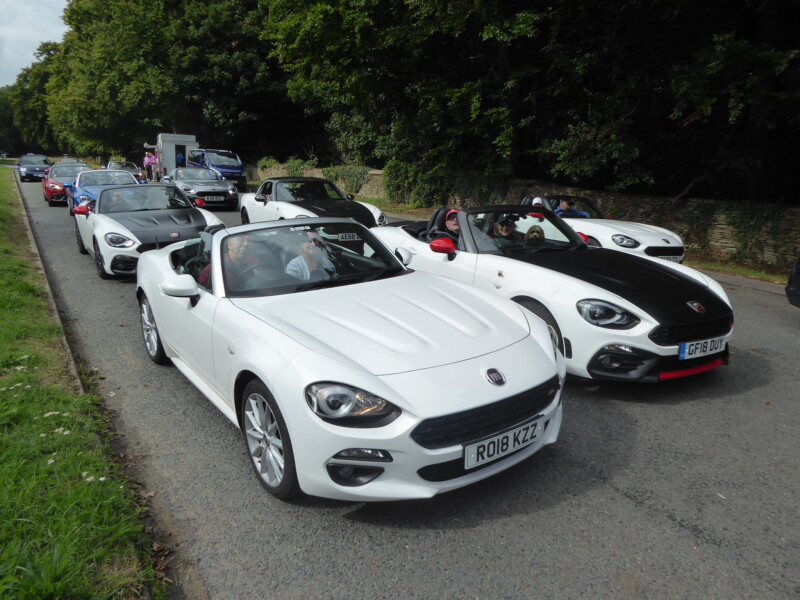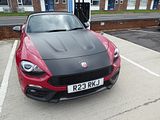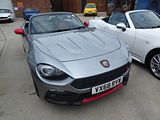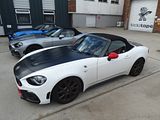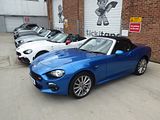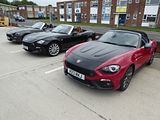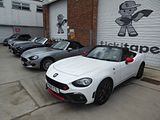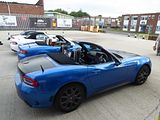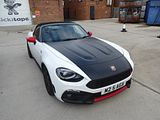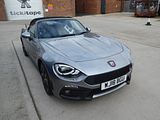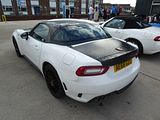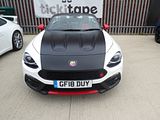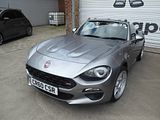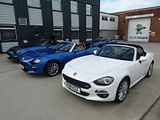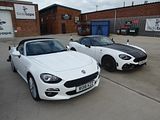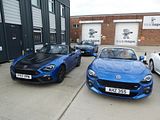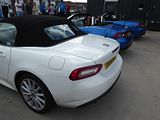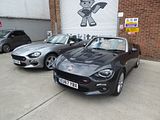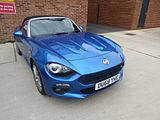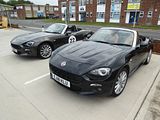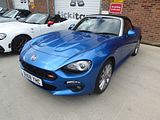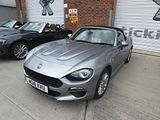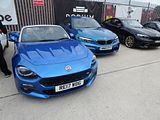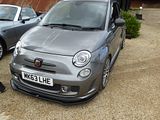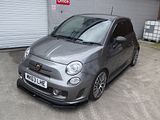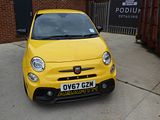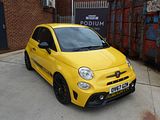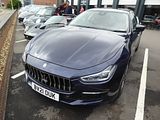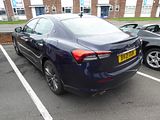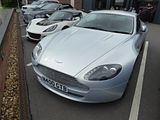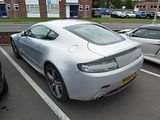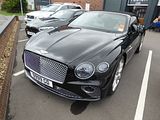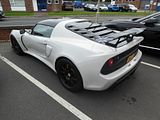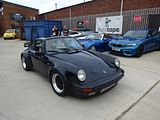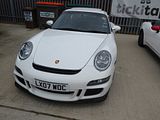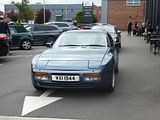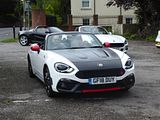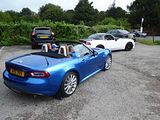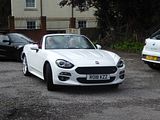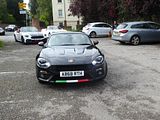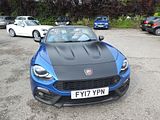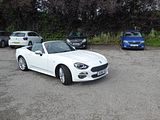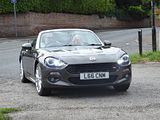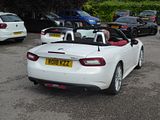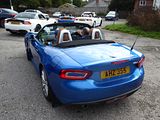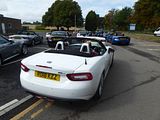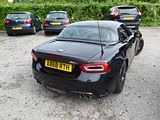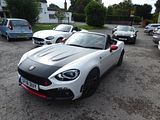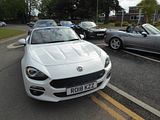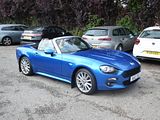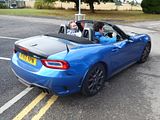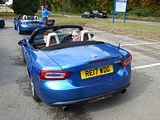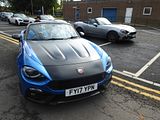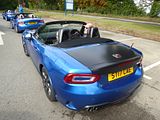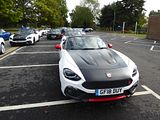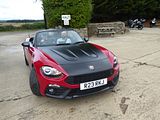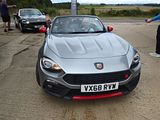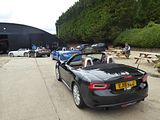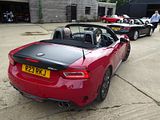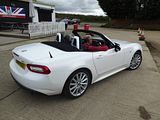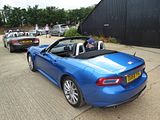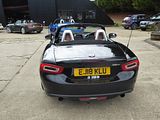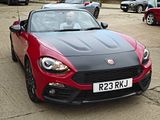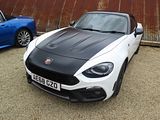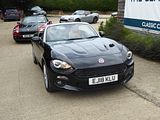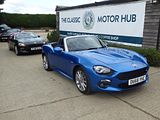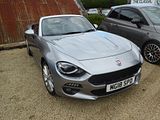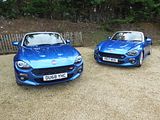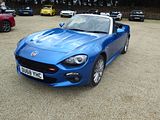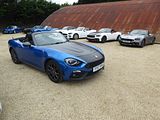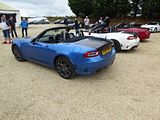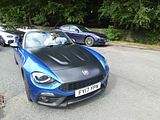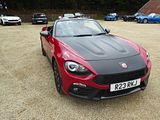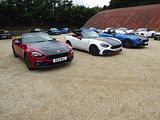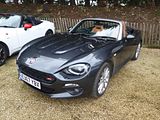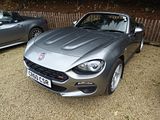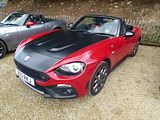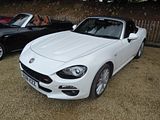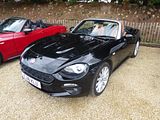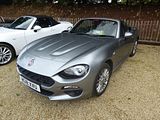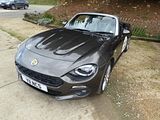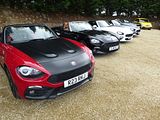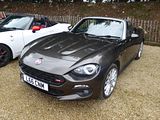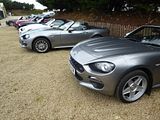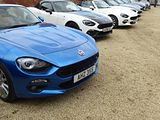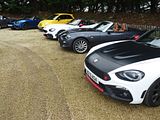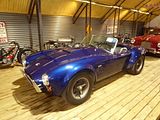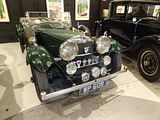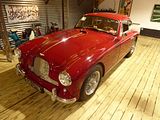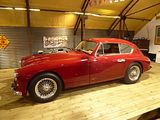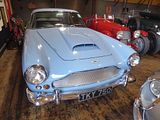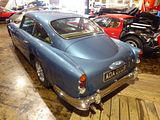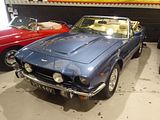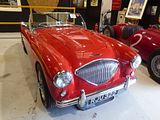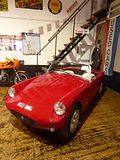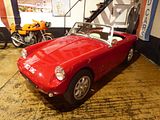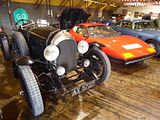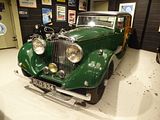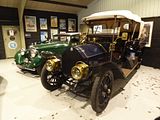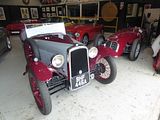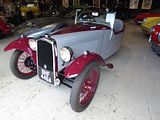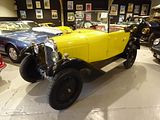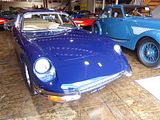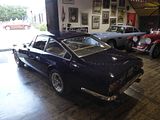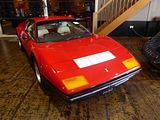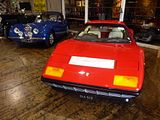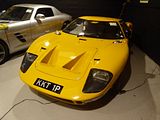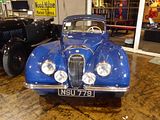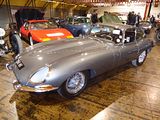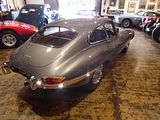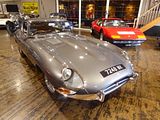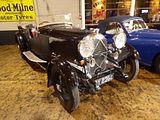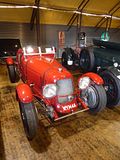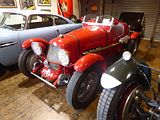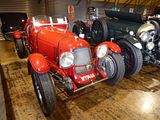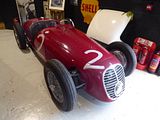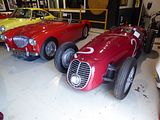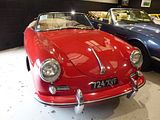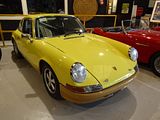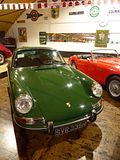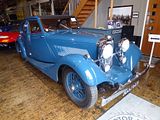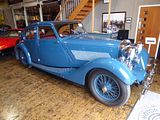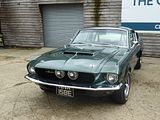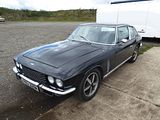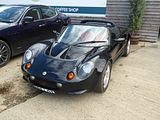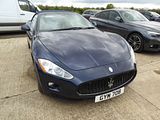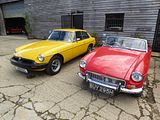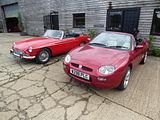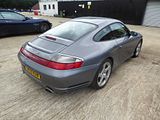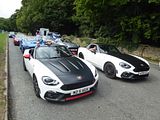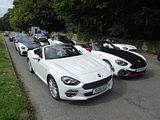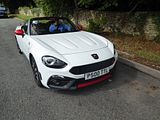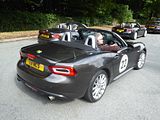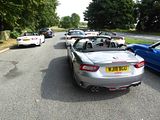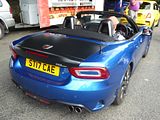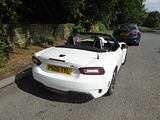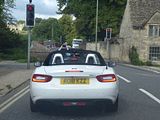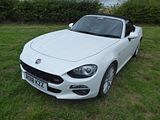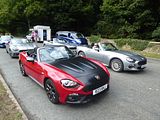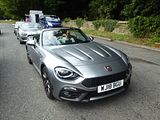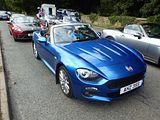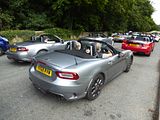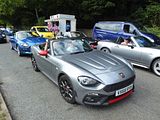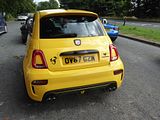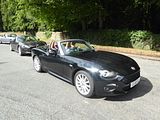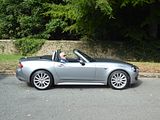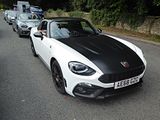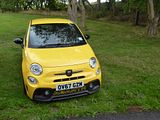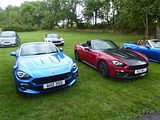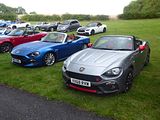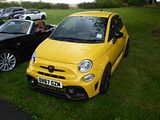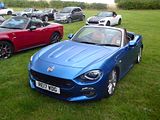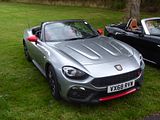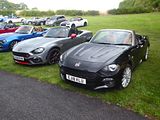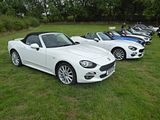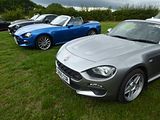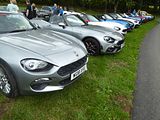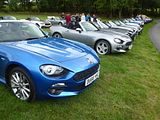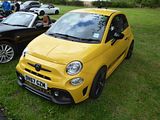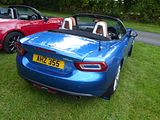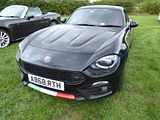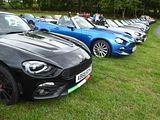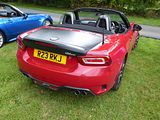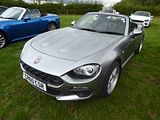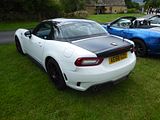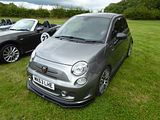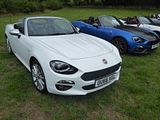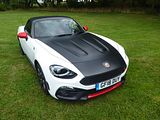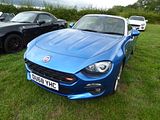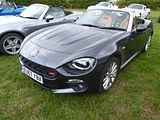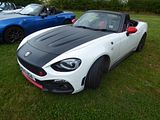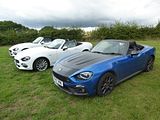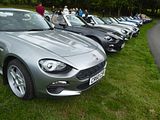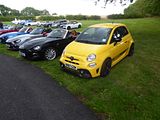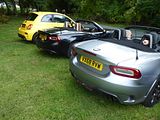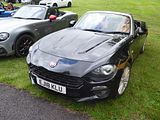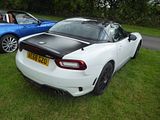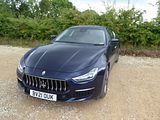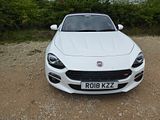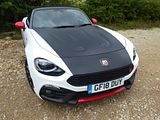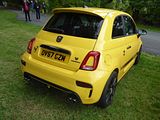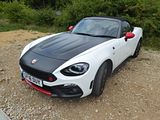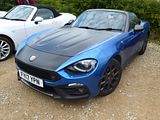Although cars are wonderful static objects and looking at them can fill many a happy hour, they are really made for driving, and the right sort of car will give its owner even more pleasure from behind the wheel than just looking at it, no matter how scenic the setting in which it is parked. And the same is largely true for car events: displays of parked up cars are great but there is rather more fun for the participants, and a variety of destinations if the event calls for some driving. But such events take more organising as someone has to recce a route and check that everything will work for as many people as sign up for it, so not surprisingly, the ratio of static to moving events tend to be very much in favour of the former. But there are people who can apply some imagination and local knowledge to create a really great day out. I went on one organised by Dan Grazier for Queen Square Car Club members a few weeks ago, and here we are, in mid September with the prospect of another one, this time masterminded by Jeremy Ingham for the Fiat/Abarth 124 Spider Owners Group but to which he then very kindly added an “and friends” qualifier in the event description. My diary happened to be clear, so I signed up.
PODIUM PLACE
Assembly point was at Podium Place which is a now quite well known venue for the car and bike enthusiast which you will find in the centre-ish of Newbury, though down a road you would probably never use unless you were lost or knew of the existence of this venue. It’s the “home” of Abarth Berkshire and the staff there always welcome any Abarth with particular enthusiasm, and they also serve excellent coffee and bacon rolls, so it was an obvious choice for the start of the day and to allow people who had travelled a bit to fortify themselves for lay ahead. In fact, some had travelled so far that they had come up the night before and I gather that a decently sized group had spend an enjoyable evening talking about 124 Spiders and Abarths and cars ad other things.
It was the Abarth 124 Spider which was the dominant car in the assembly of cars, of course, with every available colour here and a mix of those with and without the Heritage Pack and an example of the GT as well as the regular car. Eagerly awaited, the 124 Spider went on sale in September 2016. A quick reminder as to what this car is: The Abarth 124 Spider was developed in parallel with the Fiat model. It does cost a lot more, and there are those who think you don’t get enough extra for your money, but those who have driven it will tell you otherwise. You certainly get more power. The 1.4 MultiAir turbo unit jumps up from 138bhp to 168bhp, while torque also increases by a modest 10Nm to 250Nm, which gives it a 0-62mph time of 6.8 seconds, which is half a second quicker than the 2.0-litre Mazda MX-5. The top speed is 143mph. It weighs just 1060kg meaning a power-to-weight ratio of 158bhp-per-tonne, and with the new Record Monza exhaust system it sounds great even at idle. The Abarth version gets a stiffer suspension setup than the regular Fiat 124 Spider, with Bilstein dampers and beefed-up anti-roll bars. Bigger Brembo brakes also feature, with aluminium calipers. It can be had with a six-speed manual or six-speed automatic transmission with paddles, and the latter gets a Sport mode for quicker shifts. Many of the UK cars sport the ‘Heritage Look’ pack, which is a no-cost option. It brings a matt black bonnet and bootlid, plus red exterior trim detailing and has proved popular. The £29,565 starting price gets you standard equipment such as cruise control, climate control, Bluetooth, a DAB radio and satnav, plus Alcantara black and red (or pure black) seat trim. The automatic gearbox is a £2,035 extra, while an optional visibility pack brings LED DRLs, auto lights and wipers and rear parking sensors.
There were also a few examples of the closely related Fiat 124 version here, too. The Fiat 124 Spider (Type 348) is a front-engine, rear-drive, two-passenger roadster manufactured by Mazda for FCA, having debuted at the 2015 LA Auto Show for model year 2016. Largely based on the fourth generation Mazda MX-5 Miata roadster, and manufactured alongside the MX-5 at Mazda’s Hiroshima plant, the 124 shares its platform, mechanicals, interior and top mechanism with the MX-5 — it is distinguished by an FCA engineered and manufactured turbocharged Multiair engine, uniquely tuned shock absorbers, unique exterior styling and slightly increased length and cargo capacity over the MX-5. In May 2012, Mazda and Alfa Romeo — at the time a subsidiary of the Fiat Group, now Stellantis — announced a joint venture to manufacture a common rear wheel drive platform. The companies would “develop two differentiated, distinctly styled, iconic and brand specific, lightweight roadsters featuring rear wheel drive”, with the two variants offering proprietary engines unique to each brand. In December 2014, FCA’s Sergio Marchionne determined Alfa Romeos would be manufactured only in Italy, saying “some things belong to a place. Alfa belongs to Italy,” adding “I remain committed to that architecture, with our powertrain. I’m not sure it will be with Alfa. But it will be with one of our brands.” At the time, Alfa Romeos were manufactured only in Italy, while Fiats were manufactured in Italy, but also globally — from Tychy, Poland, to Toluca, Mexico. With their prior agreement in place — for FCA to market a roadster based on the MX-5 to be manufactured by Mazda at its Hiroshima factory — FCA conceived of marketing a Fiat badged variant in lieu of the Alfa Romeo variant. In August 2016, FCA formally announced the Fiat 124 Spider based on the Mazda ND platform. In December 2016, the Detroit News said “in partnering with Mazda’s MX-5 Miata to resurrect the classic Fiat 124 Spider, Fiat Chrysler not only gained a halo sports car for its struggling Italian brand, but likely saved the most celebrated small sports car of the past 25 years (the MX-5)” — citing the markedly increased cost of developing a new car at the time and “the costliest wave of government regulation since the 1970s.” The 124 Spider was powered by Fiat’s 1.4 litre MultiAir turbocharged inline-four, producing 140 PS (138 bhp) and 240 Nm (177 lb/ft) of torque in European specification—and 160 bhp and 184 lb/ft (249 Nm) of torque in North American specification.[4] The 124 manual transmission is from the third generation MX-5’s six speed transmission to cope with the turbo’s torque. Multiair is a hydraulically actuated variable valve timing (VVT) engine technology enabling “cylinder by cylinder, stroke by stroke” control of intake air directly via a gasoline engine’s inlet valves. Developed by Fiat Powertrain Technologies, the technology bypasses a primary engine inefficiency: pumping losses caused by restriction of the intake passage by the throttle plate, used to regulate air feeding the cylinders. At the 124’s debut, Fiat marketed a 124 Spider Anniversary edition, with 124 units carrying the designation—to commemorate the 50th anniversary of original 124 Sport Spider. Including features of the 124 Spider Lusso Plus trim, the edition also includes chromed mirrors, red ‘124’ badge on the front grille, interior numbered plaque, red exterior and black leather interior. In January 2019, FCA announced the Fiat 124 Spider was to be withdrawn from the market in the United Kingdom with immediate effect. The Abarth 124 Spider continued to be sold, but this too was withdrawn from the UK market in April 2019. On December 23, 2020, Stellantis announced the 124 Spider and 500 were to be withdrawn from their North American model lineup after the 2020 model year and would not return for 2021, as is the situation with 500L. These models were expected to sell into 2021 until stock depletion.
Joining the group were a couple of examples of the bigger-selling Abarth 595 range. This is Mitch Witts’ Series 3 car. Having used the legendary 695 badging from the 1960s on the Tributo cars, at the 2012 Geneva Show, Abarth dusted off the 595 name that had been used on the less powerful of the Nuova 500 based cars of the same generation, and created two new versions which we should think of as Series 2 cars, the 595 Turismo and Competizione, both of which could be bought in either closed or open top C guise, with either the 5 speed manual or robotised automated gearshifts. Both models had the 160 bhp engine as standard. Effectively they were a replacement for the Esseesse kit, and it meant that the cars were produced complete at the factory, rather than needing the dealer to undertake the upgrade (and the associated paperwork), though Abarth did not withdraw the Esseesse kits from the market for some while. Turismo, as the name suggests was aimed slightly less extreme in intent, featuring standard leather upholstery, upgraded dampers and climate control, Xenon headlights and Alutex interior details. The sportier Abarth 595 Competizione replaced the leather seats with Sabelt cloth sport seats and Alutex with aluminium, while adding p-cross-drilled brakes and the Record Monza dual-mode exhaust.
And this one is Theo Sloot’s Series 4. The Series 4 version of the familiar 595 first reached the markets in the middle of 2016. After rumours had circulated all winter following the launch of the facelifted Fiat 500 in 2015, Abarth finally unveiled the Series 4 at the end of May 2016. Initially, we were told that the cars would not be available in the UK until September, but that came forward somewhat, with dealers all receiving demo cars in June, and the first customers taking delivery in July. Three regular production versions of both the closed car and the open-topped C were initially available, all badged 595, and called Custom, Turismo and Competizione, as before, though numerous limited edition models have since appeared and in most case disappeared. The most significant changes with the Series 4 are visual, with a couple of new colours, including the much asked for Modena Yellow and a different red, called Abarth Red, which replaces both the non-metallic Officina and – slightly surprisingly – the tri-coat pearlescent Cordolo Red. as well as styling changes front and rear. The jury is still out on these, with many, me included, remaining to be convinced. At the front, the new air intake does apparently allow around 15 – 20 % more air in and out, which will be welcome, as these cars do generate quite a lot of heat under the bonnet. Competizione models for the UK retain the old style headlights, as they have Xenon lights as standard, whereas the Custom and Turismo cars have reshaped units. At the back, there are new light clusters and a new rear bumper and diffuser. Inside, the most notable change is the replacement of the Blue & Me system with a more modern uConnect Audio set up, which brings a new colour screen to the dash. Mechanically, there is an additional 5 bhp on the Custom (now 145) and Turismo (now 165 bhp) and the option of a Limited Slip Diff for the Competizione, which is likely to prove a popular option. Details of the interior trim have changed, with a filled-in glovebox like the US market cars have always had, and electric windows switches that are like the US ones, as well as a part Alcantara trim to the steering wheel in Competizione cars.
Final car in the group was me, with my Maserati Ghibli.
Podium Place is open for anyone to just drop in and so there are always a number of interesting cars parked up out front, many of which do not stay that long. Whilst we were there, these were the cars that caught my eye:
Aston Martin Vantage: Following the unveiling of the AMV8 Vantage concept car in 2003 at the North American International Auto Show designed by Henrik Fisker, the production version, known as the V8 Vantage was introduced at the Geneva Motor Show in 2005. The two seat, two-door coupé had a bonded aluminium structure for strength and lightness. The 172.5 inch (4.38 m) long car featured a hatchback-style tailgate for practicality, with a large luggage shelf behind the seats. In addition to the coupé, a convertible, known as the V8 Vantage Roadster, was introduced later in that year. The V8 Vantage was initially powered by a 4.3 litre quad-cam 32-valve V8 which produced 380 bhp at 7,300 rpm and 409 Nm (302 lb/ft) at 5,000 rpm. However, models produced after 2008 had a 4.7-litre V8 with 420 bhp and 470 Nm (347 lb/ft) of torque. Though based loosely on Jaguar’s AJ-V8 engine architecture, this engine was unique to Aston Martin and featured race-style dry-sump lubrication, which enabled it to be mounted low in the chassis for an improved centre of gravity. The cylinder block and heads, crankshaft, connecting rods, pistons, camshafts, inlet and exhaust manifolds, lubrication system and engine management were all designed in house by Aston Martin and the engine was assembled by hand at the AM facility in Cologne, Germany, which also built the V12 engine for the DB9 and Vanquish. The engine was front mid-mounted with a rear-mounted transaxle, giving a 49/51 front/rear weight distribution. Slotted Brembo brakes were also standard. The original V8 Vantage could accelerate from 0 to 60 mph in 4.8 seconds before topping out at 175 mph. In 2008, Aston Martin introduced an aftermarket dealer approved upgrade package for power and handling of the 4.3-litre variants that maintained the warranty with the company. The power upgrade was called the V8 Vantage Power Upgrade, creating a more potent version of the Aston Martin 4.3-litre V8 engine with an increase in peak power of 20 bhp to 400 bhp while peak torque increased by 10 Nm to 420 Nm (310 lb/ft). This consists of the fitting of the following revised components; manifold assembly (painted Crackle Black), valved air box, right and left hand side vacuum hose assemblies, engine bay fuse box link lead (ECU to fuse box), throttle body to manifold gasket, intake manifold gasket, fuel injector to manifold seal and a manifold badge. The V8 Vantage had a retail price of GB£79,000, US$110,000, or €104,000 in 2006, Aston Martin planned to build up to 3,000 per year. Included was a 6-speed manual transmission and leather-upholstery for the seats, dash board, steering-wheel, and shift-knob. A new 6-speed sequential manual transmission, similar to those produced by Ferrari and Lamborghini, called Sportshift was introduced later as an option. An open-topped model was added to the range in 2006 and then in the quest for more power a V12 Vantage joined the range not long after. There were no fewer than 18 different versions of the car produced over its model life
Bentley Continental GTC
Lotus Elise: It is now over 20 years since Lotus launched the Elise, a model which showed a return to the core values of simplicity and light-weight which were cornerstones of Colin Chapman’s philosophy when he founded the marque in 1955. The first generation Elise was produced for just over 4 years, with a replacement model, the Series 2 arriving in October 2000. It came about as the Series 1 could not be produced beyond the 2000 model production year due to new European crash sustainability regulations. Lacking the funding to produce a replacement, Lotus needed a development partner to take a share of investment required for the new car. General Motors offered to fund the project, in return for a badged and GM-engined version of the car for their European brands, Opel and Vauxhall. The result was therefore two cars, which although looking quite different, shared much under the skin: a Series 2 Elise and the Vauxhall VX220 and Opel Speedster duo. The Series 2 Elise was a redesigned Series 1 using a slightly modified version of the Series 1 chassis to meet the new regulations, and the same K-series engine with a brand new Lotus-developed ECU. The design of the body paid homage to the earlier M250 concept, and was the first Lotus to be designed by computer. Both the Series 2 Elise and the Opel Speedster/Vauxhall VX220 were built on the same production line, in a new facility at Hethel. Both cars shared many parts, including the chassis, although they had different drive-trains and power-plants. The VX220 carried the Lotus internal model identification Lotus 116, with the code name Skipton for the launch 2.2 normally aspirated version and Tornado for the 2 litre Turbo which came out in 2004. Fitted with 17 inch over the Elise’s 16 inch front wheels, the Vauxhall/Opel version ceased production in late 2005 and was replaced by the Opel GT for February 2007, with no RHD version for the United Kingdom. The Elise lived on. and indeed is still in production now, some 15 years later, though there have been countless different versions produced in that time. Whilst the first of the Series 2 cars came with the Rover K-Series engine, and that included the 111S model which had the VVC engine technology producing 160 hp, a change came about in 2005 when Lotus started to use Toyota engines. This was initially due to Lotus’ plans to introduce the Elise to the US market, meaning that an engine was needed which would comply with US emissions regulations. The selected 1.8 litre (and later 1.6 litre) Toyota units did, and the K-series did not. that MG-Rover went out of business in 2005 and engine production ceased confirmed the need for the change. Since then, Lotus have offered us track focused Elise models like the 135R and Sport 190, with 135 bhp and 192 bhp respectively, as well as the 111R, the Sport Racer, the Elise S and Elise R. In 2008 an even more potent SC model, with 218 bhp thanks to a non-intercooled supercharger was added to the range. In February 2010, Lotus unveiled a facelifted version of the second generation Elise. The new headlights are now single units; triangular in shape they are somewhat larger than the earlier lights. The cheapest version in Europe now has a 1.6 litre engine to comply with Euro 5 emissions, with the same power output as the earlier 1.8 136bhp car. Lotus has been through some difficult times in recent years, but things are looking more optimistic again, with production numbers having risen significantly in the last couple of years, after a period when next to no cars were made.
Lotus Exige S3: At the Frankfurt 2011 Show, the 2012 version of the Exige S was announced. It features a supercharged 3.5 litre V6 engine (from the Evora S) rated at 345 hp. In 2013, a roadster version was introduced with only minor changes to the design for the removable top. The engine and performance were virtually unchanged from the coupe. To accommodate the V6 engine, the new model is approximately 25 cm (9.8 inches) longer and 5 cm (2.0 in) wider (exterior bodywise) than the model with the inline-four engine, being 4,052 mm (159.5 inches) long, 1,802 mm (70.9 in) wide (not counting the mirrors) and 1,153 mm (45.4 in) tall. The drag coefficient is 0.433. Since that time there have been a bewildering array of different versions and you need to be a real marque expert to tell them all apart. The policy has worked, though, as sales have remained steady whilst Lotus try to amass the finances to develop any all new models. The Exige V6 Cup is a track oriented version of the Exige S while the Exige CupR is the track-only version of Exige V6 Cup. The Exige V6 Cup is offered for sale in the United States as a track only car. If purchased, US Lotus Dealers will only provide a bill of sale instead of a title. The vehicles were unveiled at the 2013 Autosport International motor show. Limited to 50 examples, the Lotus Exige 360 Cup was revealed on 14 August 2015. The car is powered by a 3.5-liter supercharged Toyota V6 delivering 355 hp. The Lotus Exige Sport 380 is a track focused and more powerful version of the Lotus Exige lineup. It was unveiled on 23 November 2016. Lotus’ CEO, Jean-Marc Gales describes it as, “The Exige Sport 380 is so good, that it is no longer the best in class, it’s now in a class of its own”, and it fulfills this statement by taking on some of the powerful and expensive super cars both on the track and the streets. The 3.5-litre, super-charged V6 engine is now uprated and produces 375 hp and 410 Nm (302 lb/ft) of torque with a 6500 rpm red line achieved by revised supercharger and ECU. It can accelerate from 0 to 60 mph in 3.5 seconds and has a top speed of 178 mph (286 km/h). The interior is also stripped out and features necessary driver aids. The Exige Sport 380 weighs 1,076 kg (2,372 lb), thanks to the extensive use of carbon fibre on the exterior as well as the interior, the application of polycarbonate windows instead of traditional glass windows and a newly designed rear transom panel which features two rear lights instead of four.The Lotus Exige Cup 380 is a more hardcore variant of the Exige Sport 380. Performance of the car remains the same as the Sport 380 but it features more aero components and a larger rear wing to produce more downforce at high speeds. The Exige Cup 380 generates 200 kg (441 lb) of downforce at its maximum speed of 175 mph (282 km/h); the top speed is reduced due to excess downforce and more drag. It features a more stripped out interior in order to save weight and other light weight carbon fiber components, Lotus states a lowest possible dry weight of only 1,057 kg (2,330 lb). On 9 November 2017, Lotus unveiled the most powerful version of the Exige to date called the Exige Cup 430, producing 430 PS (424 hp) and using the Evora GT430’s powertrain, modified to fit in the smaller Exige. The car body can produce 220 kg (485 lb) of downforce. The Cup 430 is 19 kg (42 lb) lighter than the Sport 380 due to the use of carbon fibre in body panels and interior and a titanium exhaust. The gearbox allows quicker gearshifts than the previous model. The Cup 430 is not offered with an automatic gearbox. The Lotus Exige Cup 430 is capable of covering the Hethel circuit in 1 minute 24.8 seconds – the fastest production car to lap the circuit – 1.2 seconds faster than the road going Lotus 3-Eleven.
Porsche 911: The 911 continued to evolve throughout the 1960s and early 1970s, though changes initially were quite small. The SC appeared in the autumn of 1977, proving that any earlier plans there had been to replace the car with the front engined 924 and 928 had been shelved. The SC followed on from the Carrera 3.0 of 1967 and 1977. It had the same 3 litre engine, with a lower compression ratio and detuned to provide 180 PS . The “SC” designation was reintroduced by Porsche for the first time since the 356 SC. No Carrera versions were produced though the 930 Turbo remained at the top of the range. Porsche’s engineers felt that the weight of the extra luxury, safety and emissions equipment on these cars was blunting performance compared to the earlier, lighter cars with the same power output, so in non-US cars, power was increased to 188 PS for 1980, then finally to 204 PS. However, cars sold in the US market retained their lower-compression 180 PS engines throughout. This enabled them to be run on lower-octane fuel. In model year 1980, Porsche offered a Weissach special edition version of the 911 SC, named after the town in Germany where Porsche has their research centre. Designated M439, it was offered in two colours with the turbo whale tail & front chin spoiler, body colour-matched Fuchs alloy wheels and other convenience features as standard. 408 cars were built for North America. In 1982, a Ferry Porsche Edition was made and a total of 200 cars were sold with this cosmetic package. SCs sold in the UK could be specified with the Sport Group Package (UK) which added stiffer suspension, the rear spoiler, front rubber lip and black Fuchs wheels. In 1981 a Cabriolet concept car was shown at the Frankfurt Motor Show. Not only was the car a true convertible, but it also featured four-wheel drive, although this was dropped in the production version. The first 911 Cabriolet debuted in late 1982, as a 1983 model. This was Porsche’s first cabriolet since the 356 of the mid-1960s. It proved very popular with 4,214 sold in its introductory year, despite its premium price relative to the open-top targa. Cabriolet versions of the 911 have been offered ever since. 911 SC sales totalled 58,914 cars before the next iteration, the 3.2 Carrera, which was introduced for the 1984 model year. Coupe models outsold the Targa topped cars by a big margin.
Porsche 997 GT3: In February 2006, Porsche unveiled the second generation of GT3, the 997 commonly now known as the 997.1 GT3. In addition to a new 415 PS 3.6 litre flat-six engine, the vehicle featured “zero lift” aerodynamics, meaning the car creates only aerodynamic downforce and no grip-diminishing “lift” upwards and away from the road surface. The GT3 made use of a modified, track oriented version of Porsche’s active PASM suspension making it the first of Porsche’s RS or GT3 versions to feature an electronically adjustable suspension system. Also available was a navigation system and Porsche’s “sports chrono” gauge package. The car went to sale in summer of 2006. A total of 917 units were sold in the United States and 46 units in Canada. The 997 GT3 has a rated 0–60 mph acceleration time of 4.1 seconds and has a top speed of 311 km/h (193 mph). Road and Track was able to achieve a 0-60 mph acceleration time of 3.8 seconds. Porsche’s official test-driver Walter Röhrl completed the Nürburgring Nordschleife in 7 minutes 42 seconds with the 997 GT3 in 2006. In 2009, Porsche launched the 2nd Generation 997 GT3 (commonly known as the 997.2 GT3, with an enlarged 3.8 litre engine rated at 435 PS. It also featured a number of new options including dynamic engine mounts and a pneumatically lifting front axle to compensate for the low ground clearance. The rear spoiler was also modified along with other parts of the bodywork. Deliveries in Europe commenced in November the same year. A total of 654 units were sold in the United States and 58 units in Canada.
Porsche 944: Whilst its precursor, the 924, had received largely positive reviews, it was criticised by many including Porsche enthusiasts for its Audi-sourced engine and although the Turbo model had increased performance, this model carried a high price, which caused Porsche to decide to develop the 924, as they had with generations of the 911. They re-worked the platform and a new all-alloy 2.5 litre inline-four engine, that was, in essence, half of the 928’s 5.0 litre V8, although very few parts were actually interchangeable. Not typical in luxury sports cars, the four-cylinder engine was chosen for fuel efficiency and size, because it had to be fitted from below on the Neckarsulm production line. To overcome roughness caused by the unbalanced secondary forces that are typical of four-cylinder engines, Porsche included two counter-rotating balance shafts running at twice engine speed. Invented in 1904 by British engineer Frederick Lanchester, and further developed and patented in 1975 by Mitsubishi Motors, balance shafts carry eccentric weights which produce inertial forces that balance out the unbalanced secondary forces, making a four-cylinder engine feel as smooth as a six-cylinder. The engine was factory-rated at 150 hp in its U.S. configuration. Revised bodywork with wider wheel arches, similar to that of the 924 Carrera GT, a fresh interior and upgrades to the braking and suspension systems rounded out the major changes and Porsche introduced the car as the 944 in 1982. It was slightly faster (despite having a poorer drag co-efficient than the 924), the 944 was better equipped and more refined than the 924; it had better handling and stopping power, and was more comfortable to drive. The factory-claimed 0-60 mph time of less than 9 seconds and a top speed of 130 mph which turned out to be somewhat pessimistic, In mid-1985, the 944 underwent its first significant changes. These included : a new dash and door panels, embedded radio antenna, upgraded alternator, increased oil sump capacity, new front and rear cast alloy control arms and semi-trailing arms, larger fuel tank, optional heated and powered seats, Porsche HiFi sound system, and revisions in the mounting of the transaxle to reduce noise and vibration. The “cookie cutter” style wheels used in the early 944s were upgraded to new “phone dial” style wheels (Fuchs wheels remained an option). 1985 model year cars incorporating these changes are sometimes referred to as “1985B”, “85.5” or “1985½” cars. For the 1987 model year, the 944 Motronic DME was updated, and newly incorporated anti-lock braking and air bags. Because of the ABS system, the wheel offset changed and Fuchs wheels were no longer an option. In early 1989 before the release of the 944S2, Porsche upgraded the 944 from the 2.5 to a 2.7 litre engine, with a rated 162 hp and a significant increase in torque. For the 1985 model year, Porsche introduced the 944 Turbo, known internally as the 951. This had a turbocharged and intercooled version of the standard car’s engine that produced 220 PS at 6000 rpm. In 1987, Car and Driver tested the 944 Turbo and achieved a 0-60 mph time of 5.9 seconds. The Turbo was the first car using a ceramic port liner to retain exhaust gas temperature and new forged pistons and was also the first vehicle to produce identical power output with or without a catalytic converter. The Turbo also featured several other changes, such as improved aerodynamics, notably an integrated front bumper. This featured the widest turn signals (indicators) fitted to any production car, a strengthened gearbox with a different final drive ratio, standard external oil coolers for both the engine and transmission, standard 16 inch wheels (optional forged Fuchs wheels), and a slightly stiffer suspension (progressive springs) to handle the extra weight. The Turbo’s front and rear brakes were borrowed from the Porsche 911, with Brembo 4-piston fixed calipers and 12-inch discs as ABS also came standard. Engine component revisions, more than thirty in all, were made to the 951 to compensate for increased internal loads and heat. Changes occurred for the 1987 model year. On the interior, the 1987 944 Turbo for North America became the first production car in the world to be equipped with driver and passenger side air bags as standard equipment. A low oil level light was added to the dash as well as a 180 mph (290 km/h) speedometer as opposed to the 170 mph speedometer on the 1986 model Turbos. Also included is the deletion of the transmission oil cooler, and a change in suspension control arms to reduce the car’s scrub radius. The engine remained the same M44/51 as in the 1986 model. In 1988, Porsche introduced the Turbo S. The 944 Turbo S had a more powerful engine (designation number M44/52) with 250 hp and 258 lb·ft torque (standard 944 Turbo 220 hp and 243 lb·ft. This higher output was achieved by using a larger K26-8 turbine housing and revised engine mapping which allowed maintaining maximum boost until 5800 rpm, compared to the standard 944 Turbo the boost would decrease from 1.75 bar at 3000 rpm to 1.52 bar at 5800 rpm. Top speed was factory rated at 162 mph. The 944 Turbo S’s suspension had the “M030” option consisting of Koni adjustable shocks front and rear, with ride height adjusting threaded collars on the front struts, progressive rate springs, larger hollow rear anti-roll/torsion bars, harder durometer suspension bushings, larger hollow anti-roll/torsion bars at the front, and chassis stiffening brackets in the front frame rails. The air conditioning dryer lines are routed so as to clear the front frame brace on the driver’s side. The 944 Turbo S wheels, known as the Club Sport design, were 16-inch Fuchs forged and flat-dished, similar to the Design 90 wheel. Wheel widths were 7 inches in the front, and 9 inches in the rear with 2.047 in offset; sizes of the Z-rated tyres were 225/50 in the front and 245/45 in the rear. The front and rear fender edges were rolled to accommodate the larger wheels. The manual transmission featured a higher friction clutch disc setup, an external cooler, and a limited slip differential with a 40% lockup setting. The Turbo S front brakes were borrowed from the Porsche 928 S4, with larger Brembo GT 4-piston fixed calipers and 12-inch discs; rear Brembo brakes remained the same as a standard Turbo. ABS also came standard. The 944 Turbo S interior featured power seats for both driver and passenger, where the majority of the factory-built Turbo S models sported a “Burgundy plaid” (Silver Rose edition) but other interior/exterior colours were available. A 10-speaker sound system and equalizer + amp was a common option with the Turbo S and S/SE prototypes. Only the earlier 1986, 250 bhp prototypes featured a “special wishes custom interior” options package. In 1989 and later production, the ‘S’ designation was dropped from the 944 Turbo S, and all 944 Turbos featured the Turbo S enhancements as standard, however the “M030” suspension and the Club Sport wheels were not part of that standard. The 944 Turbo S was the fastest production four cylinder car of its time. For the 1987 model year, the 944S “Super” was introduced, featuring a high performance normally aspirated, dual-overhead-cam 16-valve 190 PS version of the 2.5 litre engine (M44/40) featuring a self-adjusting timing belt tensioner. This marked the first use of four-valve-per-cylinder heads and DOHC in the 944 series, derived from the 928 S4 featuring a redesigned camshaft drive, a magnesium intake tract/passages, magnesium valve cover, larger capacity oil sump, and revised exhaust system. The alternator capacity was 115 amps. The wheel bearings were also strengthened and the brake servo action was made more powerful. Floating 944 calipers were standard, but the rear wheel brake circuit pressure regulator from the 944 turbo was used. Small ’16 Ventiler’ script badges were added on the sides in front of the body protection mouldings. Performance was quoted as 0 – 100 km/h in 6.5 seconds and a 144 mph top speed due to a 2857 lb weight. It also featured an improved programmed Bosch Digital Motronic 2 Computer/DME with dual knock sensors for improved fuel performance for the higher 10.9:1 compression ratio cylinder head. Like the 944 Turbo, the 944S received progressive springs for greater handling, Larger front and rear anti-roll bars, revised transmission and gearing to better suit the 2.5 litre DOHC higher 6800 rpm rev limit. Dual safety air bags, limited-slip differential, and ABS braking system were optional on the 944S. A Club Sport touring package (M637) was available as was the lightweight 16 inch CS/Sport Fuch 16×7 and 16×9 forged alloy wheels. This SC version car was raced in Canada, Europe and in the U.S. IMSA Firehawk Cup Series. Production was only during 1987 and 1988. It was superseded in 1989 by the ‘S2’ 944 edition. The 1987 944S power-to-weight ratio was such that it was able to accelerate from 0 to 62 mph in 6.5 seconds thus matching the acceleration of its newer larger displacement 3.0 litre 944 S2 sibling. In 1989 the 944S2 was introduced, powered by a 211 PS normally aspirated, dual-overhead-cam 16-valve 3.0 litre version of the 944S engine, the largest production 4-cylinder engine of its time. The 944S2 also received a revised transmission and gearing to better suit the 3.0 litre M44/41 powerplant. The 944S2 had the same rounded nose and a rear valance found on the Turbo model. This was the first example of the use of an integrated front bumper, where the fender and hood profiles would merge smoothly with the bumper, a design feature that has only now seen widespread adoption on the 1990 onward production cars. Performance was quoted as 0-60 mph in 6.0 seconds with a top speed of 240 km/h (150 mph) via manual transmission. A Club Sport touring package (M637) was also available. Dual air bags (left hand drive models), limited-slip differential and ABS were optional. Series 90 16-inch cast alloy wheels were standard equipment. In 1989, Porsche released the 944 S2 Cabriolet, a first for the 944 line that featured the cabriolet body built by ASC-American Sunroof Company at Weinsberg Germany. The first year of production included sixteen 944 S2 Cabriolet for the U.S. market. For the 1990 model year, Porsche produced 3,938 944 S2 Cabriolets for all markets including right-hand drive units for the United Kingdom, Australia and South Africa. This car was raced, including the British championship that was called the Porsche Motorsport Championship. Production was during 1989, 1990, and 1991. The 944 S2 power-to-weight ratio was such that it was able to accelerate from 0 to 60 mph in 6.5 seconds. In February 1991, Porsche released the 944 Turbo Cabriolet, which combined the Turbo S’s 250 hp engine with the cabriolet body built by ASC-American Sunroof Company at Weinsberg Germany. Porsche initially announced that 600 would be made; ultimately 625 were built, 100 of which were right-hand drive for the United Kingdom, Japanese, Australian, and South African market. None were imported to the U.S. and The Americas. In early 1990, Porsche engineers began working on what they had intended to be the third evolution of the 944, the S3. As they progressed with the development process, they realised that so many parts were being changed that they had produced an almost entirely new vehicle. Porsche consequently shifted development from the 944 S/S2 to the car that would replace the 944 entirely, the 968. The 944’s final year of production was 1991. A grand total 163,192 cars in the 944 family were produced between 1982 and 1991. This made it the most successful car line in Porsche’s history until the introductions of the Boxster and 997 Carrera.
EN ROUTE and REGROUPING
Keeping even a small convoy of cars together is exceedingly difficult even on motorways but when the route starts off in the centre of Newbury with a combination of traffic lights and roundabouts then it is pretty much guaranteed that cars will get separated almost immediately. Jeremy had thought of that and so had included the first regrouping point on the edge of Newbury on the Wantage road with an area we could assemble in whilst everyone caught up. Needless to say this was a photo opportunity in its own right.
Things did get easier after this point, as there were no large towns to traverse, but even so, there were a number of other places included where we could assemble everyone again before setting off with almost everyone in a long line.
CLASSIC MOTOR HUB
Finally we arrived at the Classic Motor Hub, just outside the pretty Cotswold village of Bibury.
Although I had last been here less than a month previously, it is always worth a visit, as the two extensive buildings house a collection of stock most of which is for sale and whilst some cars do stick around for some time, others come and go relatively quickly, so you can be pretty sure there is likely to be something fresh to see. And even if there is not, as the cars get moved around the site a fair bit there are plenty of different photo opportunities for cars that I may have seen before. Time was a bit limited on this occasion but here are the stock cars that caught my camera.
1967 AC Cobra 289: It was a simple but devastatingly effective recipe. Former racer Carroll Shelby – winner of the 1959 Le Mans 24 Hours in a works Aston Martin – approached AC with the idea of dropping Ford’s latest V8 engine into the venerable Ace chassis, which could trace its roots back to the early 1950s. The result was the Cobra – a genuine performance icon. After a short run of cars fitted with 260 cubic-inch engines, the definitive 289 model was introduced, and while the Cobra was immediately successful in domestic US racing, Shelby had his sights set on toppling Ferrari in the International Championship for GT Manufacturers. Developments such as all-round disc brakes and rack-and-pinion steering came thick and fast, and in 1965 the Cobra – in Peter Brock-designed Daytona Coupe form – achieved its goal and became a world champion. The next major step for the Cobra came with the fitment of the 427 cubic-inch Ford V8. The monstrous new engine necessitated a chassis redesign, so the main chassis rails were moved further apart and coil-spring suspension replaced the outdated leaf springs of previous models. The body was wider, with flared arches to accommodate the Halibrand wheels, the main air intake was enlarged, and everything about this latest Cobra was even more aggressive than the 289 model. The 427 offered truly breath-taking performance, but the world had moved on, and Shelby had grown ever closer to Ford and was increasingly busy with other projects. The final batch of cars was invoiced by AC in December 1966. But that was not the end. AC decided to build its own run of cars using the 427’s coil-spring chassis but allied to the 289 engine. With Ford now owning the rights to the Cobra name, the British company had to call its latest model the AC 289 Sports, but these cars – considered by some to represent the perfect blend of later chassis and earlier engine – nonetheless represent the final chapter in one of the famous automotive stories of all. This AC 289 Sports is chassis number COB6116, and was delivered on 31 January 1967 via HW Motors Ltd in Walton-on-Thames. Its first owner was David Skailes, a noted racer who had competed in an Aston Martin DB4 GT and Ferrari 250 LM. His right-hand-drive AC was finished in Pacific Green with Black upholstery, and it was specified with a hardtop and radio. After part-exchanging a 1965 Marcos 1800, Skailes was left to pay the grand total of £2183 15s. A hand-written note from Skailes in the history file explains that the Marcos belonged to his brother Ian, and that the AC was delivered by none other than George Abecassis – co-founder of HWM and a well-known former racing driver. Skailes used the AC as a road car and after he sold it, it passed through a couple of owners in the early 1970s before ending up with Brian Bolton. He sent it to marque specialist Brian Angliss, who converted the car to full 427 specification, including side-oiler engine, top-loader gearbox and wide wheelarches. It appeared in that form in Rod Grainger’s book Cobra – Super Profile, wearing the registration number 750 HOT. In the mid-1980s, the AC was sold by Rod Leach to James Jordan, who kept the car in the UK before taking it with him to South Africa during the 1990s. While there, the AC was repainted and mechanically rebuilt by Hi-Tech Autos of Port Elizabeth. The car was sold via a Christie’s auction in November 2002, and the new owner had it appraised and fettled by AC Autokraft before using it extensively on trips across Europe, including events such as the Ennstal Classic and the Kitzbühl Alpine Rally. Its next custodian was based in Japan and had the AC repainted metallic blue. He also replaced the 427 engine with a small-block 302 unit. Since 2015, the AC’s most recent owner has been painstakingly returning it to correct 289 specification, including the fitment of a correctly dated 289 ‘Hi-Po’ engine. The car has also been reunited with its original Surrey registration number. The COB6116 chassis number is stamped on the bonnet, doors and boot lid – showing those to be original to the car – and this AC 289 boasts continuous history all the way back to David Skailes in 1967. It’s also sensational to drive, and noticeably quicker than other 289s that The Classic Motor Hub has been privileged to offer for sale. As one of only 20 right-hand-drive AC 289 Sports that left the Thames Ditton factory between April 1966 and February 1969, this car offers a rare opportunity to acquire a well-documented example of a car that is a Cobra in all but name.
1933 Alvis Speed 20 SB: Founded in 1919 by Thomas George John, Alvis soon became known for its small, well-engineered and sporting cars. Based in Holyhead Road, Coventry, the company achieved great success in motor racing and was unafraid to innovate – during the mid-1920s, for example, it developed competition cars that featured front-wheel drive, all-independent suspension, and a 1.5-litre twin-overhead-camshaft engine. As the 1930s dawned, Alvis began to move upmarket and in 1932 it introduced the Speed 20. A new low-slung chassis enabled coachbuilders to design a range of handsome, well-proportioned bodies, and the Speed 20 was enthusiastically received by the motoring press. The original SA model used a 2511cc six-cylinder engine, which produced 87bhp and was carried over to the SB. First unveiled at the 1933 Motor Show, the SB was fitted with independent front suspension and an all-synchromesh gearbox – the latter representing a major step forward when compared to the ‘crash’ gearboxes then in widespread use. It was said that the development of this new unit was at least partly due to the fact that Alvis engineer AF Varney used to struggle with double-declutching… The Speed 20 sold well and played a crucial role in enabling Alvis to cope with the difficult economic conditions of the early 1930s. In fact, so well regarded was this new model that Rolls-Royce considered the Speed 20 to be the benchmark in the 20hp class. After being updated into the 2762cc SC and finally the SD, production came to an end in 1936. By then, Alvis had introduced the 3.5-litre model, which was based on the Speed 20 and was soon developed into the Speed 25. Some owners subsequently fitted the more powerful Speed 25 engine – which produced 106bhp – to their Speed 20. As war clouds gathered, Alvis moved into the production of aero engines and military vehicles – but continued to build cars as well. ‘An aristocrat among automobiles’ as a 1938 advertisement put it. ‘An exclusive car for exclusive people who will have nothing but the best’.On 27 March 1934, an advert for London-based Alvis dealer Charles Follett appeared in The Motor, heralding the success of the Coventry marque’s cars on the recent RAC Rally. Pictured in that advert was this very Alvis Speed 20, which had won its class on that event in the hands of its first owner, WEC Watkinson. The Vanden Plas tourer was originally registered on 1 December 1933, having been acquired by Watkinson, who lived in Malvern. He was a keen rally enthusiast who competed in various MGs and intended to use the Alvis in the same way – as well as being his daily transport. Watkinson drove the Speed 20 on the RAC Rally for four consecutive years, starting in 1934, and by the time he sold it in 1938 he had covered 45,784 miles – all carefully logged in his notebook. As well as competition use, Watkinson also took the car on four trips to the continent. In early 1934 he drove to Grindelwald in Switzerland for a skiing and winter sports holiday, and photographs show the Alvis negotiating snow-packed roads at the foot of the Eiger and at Zweilütschinen on the way home. That summer, he also visited the First World War battlefields in France and Belgium with his old history don from Oxford University, d’Arcy Dalton. Watkinson noted each time that he drove the Alvis more than 100 miles in one day, and on no fewer than 37 occasions he recorded more than 200 miles. He also once clocked up 96 miles giving people lifts to the Polling Office so that they could vote in the General Election. Watkinson owned the Alvis until June 1938, when it was advertised in The Autocar and sold to its next owner – Commander Marshall of Saltash in Cornwall. He later became Sir Douglas Marshall and kept the Speed 20 all the way through the Second World War and into the 1950s. In January 1953, WP 608 was sold by Elliot & Sons of Bideford to Eric Cleaton-Hart. He took the car with him when he moved to the Midlands and in 1956 sold it to an airline pilot who flew out of Birmingham Airport. It was then owned by Gordon Butler between 1957 and 1968, when it was sold to Don Jones. As well as being a motoring enthusiast, Shropshire-based Jones was a fine cricketer. He had the Alvis restored during his long ownership and started to research the car’s history. That process involved getting in touch with Suzanne Moodie, who was the daughter of WEC Watkinson. That contact led to Suzanne and her husband David acquiring the Alvis when Don Jones sadly passed away in July 2000. In 2010, the Speed 20’s engine was rebuilt at a cost of just over £18,000, and the car is presented in its original colour combination. Now sporting a beautiful patina, this Alvis is being offered for sale with a copy of its original factory car record, a wonderful selection of period photographs, commemorative tankards from the 1934 London-Edinburgh Trial and 1936 Torquay Rally, and a silver salver in honour of its class win in the coachwork competition on the 1934 Bournemouth Rally.
1953 Aston Martin DB2/4: This immaculate Aston Martin DB2/4, 521 UYN, has recently been restored, with the result that it is now an exceptional example of the Feltham marque’s handsome Grand Tourer. Chassis number LML/1027 was a left-hand-drive North American export that was built on 5th July 1955. It was dispatched on 28th July that year to the Peter Satori Company in Pasadena, California, and the build sheet notes that it had been fitted with the optional Dunlop Roadspeed whitewall tyres.
1960 Aston Martin DB4 Series II: When the Aston Martin DB4 was launched in 1958, it marked the beginning of a new era for the British marque. John Wyer was dissatisfied with the styling of an initial 1956 prototype for the proposed ‘next generation’ of Aston Martin, and insisted that the company should turn to an Italian design house. After brief overtures to Pinin Farina, a deal was done with Touring of Milan – from which Aston Martin also licensed the Superleggera method of lightweight construction, which involved using a framework of small tubes on a rigid platform chassis. Touring’s crisp, clean shape was fitted around a new 3.7-litre six-cylinder engine that had been designed by Tadek Marek. The twin-cam unit featured an aluminium block for the sole reason that Aston Martin’s favoured iron foundry had no capacity for 18 months, but one of its related companies – Birmingham Aluminium – could start straight away. Suspension was via coil springs and wishbones at the front, with a live axle at the rear plus coil springs and lever-arm dampers. Rack-and-pinion steering was fitted in place of the steering box used on the earlier DB2 series, while Dunlop disc brakes were used all round. When it was launched, the DB4 cost the same as two Jaguar XK 150s but offered near-140mph performance and fabulous looks. It was regularly updated throughout its production run, from the 1958 Series I to the Series V of late 1962. From 1961 onwards, there were also the options of a convertible body style and the more powerful Vantage model. In addition, there was the short-wheelbase, competition-focused DB4 GT. Just over 1000 DB4s were built before the model was replaced by the updated DB5 at the 1963 Frankfurt Motor Show. First registered on 20 May 1960, this Aston Martin DB4 is chassis number DB4/303/R. It left the Newport Pagnell factory finished in Wedgewood Blue, with Off White leather trim, and the logbook records that it was delivered new to Alfresco Garage in Bradford. The DB4 subsequently spent most of its life in the north of England. In November 1960, it was acquired by Mr Moore-Cartwright in County Durham, before passing to Mr Wesley Oliver in Newcastle six months later. On 5 May 1964, the Aston was registered in the name of Peter Brewer in Cheshire. Brewer owned the ex-Pat Fairfield ERA R4A at that time, and apparently used the DB4 to tow the pre-war voiturette single-seater to race meetings. Macclesfield-based John Nicol bought the Aston Martin in November 1965 and it remained in his family until 2006, when it was offered for sale at the Bonhams Goodwood Festival of Speed auction. By that time, it had covered only 57,000 miles from new and was noted as being a highly original, unrestored and well cared-for example. The engine – number 370/318 – had been rebuilt to ‘big valve specification’ by Headshop in Warrington less than 1000 miles before it was sold, having previously been rebuilt by Oselli in 1997. The DB4 remained unrestored with its next custodian, who enjoyed a trip down to Monaco with it for the Historic Grand Prix. The car was then sold again in late 2012, and a pre-purchase inspection by a marque specialist noted that, while it could be used as an ‘everyday DB4’, it would soon be in need of cosmetic and mechanical attention. He noted that it ‘would make a very good car to restore as it is complete and shows no sign of poor repairs so often carried out in the past when the cars were not so valuable’. The decision was made by the new owner to treat the Aston Martin to a complete restoration, which was carried out between 2013 and 2015. Parts were sourced from Aston Martin Dorset, while the rechroming, bodywork and respray were carried out by XK Engineering in Coventry. Mike Thomas did the trim work, and the car’s history file documents each stage of the project in painstaking detail. There is also a CD containing photographs taken during the restoration. Presented in its original shade of Wedgewood Blue, with a blue interior, this Aston Martin DB4 is in immaculate concours-ready condition and is now being offered for sale by the Classic Motor Hub. As well as all paperwork relating to the restoration, its history file includes the original log book and build sheet, plus early servicing work carried out between 1960 and 1963, and MoT certificates dating back to 1967.
1964 Aston Martin DB5: This beautifully presented Aston Martin DB5 is chassis number 1577/R. First delivered on 28 May 1964, its guarantee was issued on 2 June and non-standard equipment included a 3.77 Powr-Lok rear axle, Motorola radio, twin Marchal foglamps, chrome wheels, a heated rear screen and three-ear wheel spinners. It is referred to as “the Airfix car” as it is he car that renowned plastic maker, Airfix, used as the basis for the model they issued in the 1960s.
1979 Aston Martin V8 Volante: Introduced in 1978, the convertible Volante was intended to broaden the appeal of Aston Martin’s V8 range, which had started with the William Towns-designed DBS V8. Introduced in 1969, that car subsequently morphed into the V8 and progressed through various incarnations. The styling was subtly tweaked and mechanical changes included a switch from fuel injection to less-troublesome Weber carburettors – then back again for the Series 5 of 1986. There was also a monstrous Vantage model, which was launched a year before the Volante and offered supercar performance. The acceleration of this flagship V8 was described in Motor Sport magazine as being ‘simply stupendous and relentless’. Aston Martins were still very much hand-built during this period, the brochure for the V8 stating that ‘the quality of craftsmanship and exclusivity is a dying art… But not in the Buckinghamshire market town of Newport Pagnell. For there, in the green country belt between London and the Midlands, is found the Aston Martin factory. A factory where only the best is good enough, and where skill, dedication and loyalty are by-words of a world-famous product.’ It’s said that 1200 hours went into making each V8 Volante, which featured an aluminium body and a 5340cc quad-cam V8 producing 300bhp. There was a choice of five-speed manual or three-speed automatic gearboxes, and this luxuriously finished Aston could sprint to 60mph in only seven seconds and carry on to a top speed of more than 140mph. Detail differences between coupé and Volante included the latter’s closed bonnet bulge – a feature that was also adopted on the Series 4 ‘Oscar India’ coupé shortly afterwards – plus a burr walnut dashboard. The Volante chassis was also strengthened along the sills and around the windscreen pillars. The Series 1 Volante lasted until 1986, when it adopted the same upgrades that were applied to the new Series 5 coupé. Production of the V8 – which had done so much to keep Aston Martin going through troubled financial times – lasted until 1989, when the Virage model was introduced. Retained by its first owner for 30 years, this Aston Martin V8 Volante is a rare example of the Newport Pagnell marque’s luxurious Grand Tourer. Only 157 right-hand-drive examples were built using Weber carburettors, before the model switched to fuel injection. Chassis number V8/COR/15133 was built on 19 October 1979 and despatched on 11 January 1980. An original UK home-market car, it was finished in Tourmaline Blue with Magnolia leather and an Off White hood, and was fitted with the three-speed automatic gearbox. The Aston Martin’s first owner was James McNeil and initially it was registered in the name of his Glasgow-based company – WJ Harte Construction Ltd – and wore the registration number 6 WJH. McNeil registered it in his own name in 1989, and held on to it until 2010. It then passed to a new owner who used it for travelling between an underground garage in Scotland and his summer home in Ascona, Switzerland. In 2018, the underside of the V8 Volante was treated to an extensive refresh, with work being carried out on the suspension and brakes. The history file includes photographs of that process, plus two service books featuring stamps going back to 1980, the period sales brochure, leather tool roll and the original Owner’s Manual. The diamond cut wheels have recently been refurbished and the Aston is presented in its original colour combination. It was featured in issue 228 of Octane magazine, with an impressed Robert Coucher writing that ‘its engine is the heart of the beast. Once fired, it is loud and proud and the whole car throbs with soulful verve… depress the throttle pedal to the stop [and] the big V8 wakes up and bellows, the Aston squats on its rear de Dion axle and takes off.’
1954 Austin Healey 100 BN1: Donald Healey founded his eponymous car company in 1945, having already served as an RFC pilot in World War One, won the Monte Carlo Rally driving an Invicta, and worked for both Riley and Triumph. With Achille Sampietro and Ben Bowden on board, the company initially built Riley-powered cars in relatively small numbers. Then, at the 1952 London Motor Show, it produced a striking new model with styling by Gerry Coker, a chassis by Barry Bilbie, and the 2660cc four-cylinder engine from an Austin A90. Leonard Lord, boss of Austin, was suitably impressed, and the Austin-Healey era was about to begin. A deal was done for Jensen to build the bodies, and final assembly took place at Austin’s Longbridge plant. The first-series Healey 100s were known as the BN1 and featured a three-speed gearbox with overdrive on second and third. Drum brakes were used all round and many of the major mechanical components came from the Austin A90. When road-tested by The Motor, a BN1 Healey 100 accelerated from 0-60mph in just over 11 seconds and went on to a top speed of 106mph. An updated BN2 model was introduced in 1955 and had a four-speed gearbox, still with overdrive on the top two ratios. The wheelarches were also slightly larger and two-tone paint was offered as an optional extra. The Healey 100 was a huge success, particularly in the North American export market – it’s thought that almost 80 percent of production went there. It was also a popular choice for motorsport, with Healey offering the more powerful 100M and the now highly coveted aluminium-bodied 100S, which had disc brakes all round and a 132bhp engine.For many enthusiasts, the Healey 100 – with its rugged four-cylinder engine and elegant styling – represents the ideal 1950s British sports car. It lasted until 1956, when it was replaced by the six-cylinder 100-6, which morphed into the 3000 three years later. This attractive Austin-Healey 100/4 was in the ownership of only two families for almost 50 years. In 1970, it was bought from John Hutson – who had owned it for two years – by London-based Andrew Koch. Three years later, the continuation logbook shows that it was registered to Andrew’s brother Michael, but in 1977 it was Andrew who sold it on Michael’s behalf. Having been looking for ‘in excess of £600’, he had to settle for £500 and the Healey passed to Brian Hughes. Hughes would own the car for almost 40 years, and it was clearly in need of some work when he acquired it. His hand-written notes show that he fitted new wings, doors, outer sills, seats and carpets. There was further expenditure on ‘parts’ with the likes of AH Spares and Moto Build, and a new wiring loom was also needed. Hughes’ carefully documented expenditure shows that, once he’d finished, he’d spent £1898.02 – including the cost of the car. Chassis number BN1/223961 was originally built on 10 February 1955 as a right-hand-drive UK-market Healey 100. It was finished in Carmen Red with black interior – a combination that it retains today – and was supplied to the Farghers & Ashtons dealership on the Isle of Man. The continuation logbook suggests that the Healey came back to the mainland in June 1958, when it was given the registration RJU 322 – which was issued in Leicestershire. In more recent years, it has been cared for by renowned marque specialist Rawles Motorsport, with a carburettor rebuild being among the jobs listed in the extensive paperwork. There is also a wealth of receipts and invoices from Hughes’ ownership, plus MoTs going all the way back to 1970. Now being offered for sale by The Classic Motor Hub, this is a superb example of the BN1 Austin-Healey 100. Presented in very original specification, it offers all the excitement that you’d expect from this stylish ‘back to basics’ 1950s sports car.
1958 Austin Healey Sprite: Launched in Monaco shortly after the Principality’s 1958 Grand Prix, the Austin-Healey Sprite was intended as a small, cheap sports car that would fit into BMC’s range beneath the larger MGA. It started a dynasty that would provide countless enthusiasts with affordable, fun motoring – a brief that it still fulfils more than 60 years later. Under the stewardship of Geoffrey Healey – son of Donald – the original Sprite featured bodywork that was designed by Gerry Coker, and its distinctive headlamps soon led to it being given the ‘Frogeye’ nickname. Barrie Bilbie’s chassis design made use of unitary construction, and the engine was a twin-carburettor version of the 948cc A-series unit that was also found in the Austin A35 and Morris 1000. Rack-and-pinion steering was used, the suspension was by coil springs and wishbones, and the live rear axle featured quarter-elliptic springs and lever-arm dampers. In 1962, a redesigned Sprite was introduced that did away with the ‘Frogeye’ styling, and an MG Midget-badged variant made its debut. As well as the facelift, the engine was enlarged to 1098cc during the Mk2’s production run and front disc brakes fitted. Over the years, the engine capacity was increased to 1275cc, but production of the Austin Sprite came to an end in 1971. Its MG Midget sibling lived on until 1980. Its fine handling and an engine that was ripe for modification meant that Sprite made a good competition car. Perhaps its most famous successes came at Sebring in Florida, with a class one-two-three in the 1959 12 Hours, which was followed by a class win and second overall (with Stirling Moss at the wheel) in the 1960 4 Hours. Supplied with in-depth notes, history and specification details – all painstakingly hand-written by its owner – this Austin-Healey Sprite offers a unique and exhilarating take on the original car’s ‘back to basics’ sports car formula. The logbook records the first owner of chassis number AN5-3479 as being Christopher Cheek of Richmond, Surrey, and it was registered 802 SMG on 8 October 1958 – the first year of Sprite production. At that point, the car was yellow and fitted with the standard 948cc A-series engine, and after Mr Cheek it passed to Mervyn Mitchell in Winchcombe, Gloucestershire. By the 1980s, the Sprite had been fitted with the 1275cc engine and four-speed gearbox from an MG Metro, as well as front disc brakes to replace the original drums. It had also been repainted red. The car was purchased by the current custodian in July 2015, and was immediately entrusted to MG performance specialist Frontline Developments. The first job was to fit an Ashley bonnet – a popular period modification that replaced the distinctive ‘Frogeye’ front end with a lighter and more streamlined panel by Ashley Laminates. A Honeybourne Mouldings hard-top was fitted, Avo telescopic dampers and an anti-roll bar were installed at the front, and the inlet and exhaust manifolds were replaced. But that was just the beginning… In 2016, a Revotec fan was fitted, a Quaife limited-slip diff was specified with a 3.9:1 final-drive ratio, and stronger halfshafts were installed. The following year, the engine was upgraded to Frontline’s 1380cc fast-road specification. An alloy cylinder head from Moss was fitted, the crankshaft was balanced and the flywheel lightened. The dynamo was replaced with an Accuspark Dynamator alternator and an alloy radiator was installed. Minilite alloy wheels were fitted and the front brake discs were increased from 8in to 9in. At the rear, 8in discs replaced the drum set-up. The power output from the modified engine is quoted as being 90bhp at 6000rpm, and it drives through a Frontline five-speed gearbox. The full specification is documented in the history file, and over the subsequent two years the owner covered another 5000 exhilarating miles in the car, which is now being offered for sale by the Classic Motor Hub. The Austin-Healey Sprite was already a fun little sports car in factory specification, but the well-chosen and beautifully engineered modifications on this example have turned it into a genuine ‘pocket rocket’ boasting chassis upgrades that will enable its new owner to exploit every last bit of its extra horsepower.
1926 Bentley 3 Litre with Vanden Plas body: The 3 Litre was the first model to be offered by WO Bentley’s new company, using an engine that was developed in-house and which took inspiration from pre-war Mercedes Grand Prix designs. The four-cylinder monobloc unit was advanced for its time and featured 16 valves, an overhead camshaft and twin plugs per cylinder. Various combinations of chassis and engine tune were offered from the beginning of production in 1921 through to its replacement by the 4½ Litre in 1929. The majority of the 1622 cars that left the Cricklewood factory were the Blue Label model, which was offered with a wheelbase of either 9ft 9½in or 10ft 10in, and had a single Smiths carburettor. The Red Label Speed model used only the shorter 9ft 9½in chassis and featured a higher-compression engine. And finally there was the Green Label Supersports model, which was built in tiny numbers on a 9ft chassis and was guaranteed to offer 100mph performance. Motor racing was part of the Bentley story from the very beginning, and in 1924 Frank Clement and John Duff won the Le Mans 24 Hours, the first of Bentley’s six victories at La Sarthe and the beginning of the ‘Bentley Boys’ legend that would take hold throughout that decade. The Bentley 3 Litre remains among the most coveted of all vintage cars, its combination of robust engineering, reliable performance and sporting pedigree giving it iconic status and the Three-Four and a half offers the very best of all Bentley experiences. This Bentley 3 Litre not only features a fascinating and meticulously researched cast of former owners, it boasts continuous history from when it first left the famous Cricklewood factory in north London and retains a fascinating history file and many years of wonderful patination. Chassis number LT 1593 was a Red Label Speed model built on the shorter 9ft 9½in frame and fitted with engine number LT 1591, plus an A-type gearbox. It was ordered by the factory with Vanden Plas four-seater sports tourer coachwork and this was the actual car displayed on the Vanden Plas stand at the 1926 London Motor Show. Registered YE 812 on 31 December that year, it was delivered in January 1927 to its first owner, Tom Moore – a wealthy young student from the Isle of Man. Moore went on to own Motor Sport magazine between 1929 and 1936, and wrote articles under the pen name of ‘Mannin’. On one occasion he documented his time with YE 812, noting that his first run with the Bentley was from London to Liverpool and that the car was capable of sustained high-speed cruising. He also admitted that he was not always as careful as he could have been with the gearbox: ‘On occasion, when both in a hurry and a bad temper, our engaging of the various ratios was not marked with the tender care which shows up the good motorist.’ In the end, the gearbox cried enough and he had to limp to the factory with it stuck in third gear. A new one was fitted and Moore continued to use the Bentley for speed trials – it was pictured in The Autocar during the 1927 Inter-Varsity Hillclimb at Ewelme Down – as well as fast motoring on the road. The highest speed he reached was apparently 97mph. In late 1927, Moore replaced YE 812 with a new 4½ Litre Bentley and the 3 Litre passed to Charles Andrae. While in his ownership, the factory fitted a new frame and straightened the front axle following an accident.. Andrae sold the Bentley in 1929 to a Mr A Chapman, and from him it was bought back by the factory. It is thought that this is when it was photographed being driven out of the Service Department – possibly by WO Bentley himself – and while it was there a desirable C-type gearbox was fitted. The next owner of YE 812 was Lt Cdr Captain EW Anstice – later Vice Admiral Sir Edmund Anstice. A wonderful letter on file from Anstice’s son David explains that he used to be woken by the sound of its engine as his father started it up to drive down to the naval base in Portsmouth. During the latter stages of Anstice’s ownership, the Bentley was kept at Milvil Farm, on land that was suddenly needed for the expansion of Lee-on-Solent airfield as the dark clouds of war approached. With Anstice being called away, the Bentley was sold in 1940 to Commander R Clutterbuck, who kept it until 1954. It passed in relatively short order to Thomas Burrows and then William Allday – who was thought to be an undergraduate at Cambridge at the time – before Charles Richard Kidd acquired it in 1958. Kidd kept the Bentley for 30 years until 1988 before it passed to its next custodian, Peter Golding, who eventually sold it in 1994 via marque specialist Stanley Mann. A rarity among Cricklewood-era Bentleys in that it boasts continuous history as well as its original engine and coachwork, this 3 Litre Red Label Speed Model is being offered for sale with a beautifully presented history file that includes period photographs, press cuttings, the factory service records, and information on its previous owners. The former owner purchased the car in 2010 and embarked upon conversion of the original 3 litre engine to 4.5 litre capacity the extensive work is detailed in over £170,000 worth of invoices contained within the history file.
1937 Bentley “Derby” 4¼ litre “Woodie”: After Bentley had gone into receivership in 1931, Rolls-Royce swooped in to buy the company from under the nose of rival Napier. The first model to be launched in this new era – during which production was moved from Cricklewood to Derby – was the 3½ Litre. Launched in 1933, this was a very different type of Bentley to those that had gone before. There was now refinement to go with the performance, and it was labelled ‘the Silent Sports Car.’ Former Bentley apprentice and VSCC stalwart Rivers Fletcher later wrote that, ‘The great charm of the new model was the exquisite lightness and precision of all the controls. The steering and brakes were delightfully smooth, accurate and sensitive.’ Its engine was based on the six-cylinder Rolls-Royce 20/25 unit, and chassis development continued through the 1930s, early modifications including a strengthening crossmember at the front end and variable dampers. Although the marque’s glory days of Le Mans success were now behind it, these handsome ‘Derby Bentleys’ became renowned for their grand-touring capabilities and were offered with a range of stylish coachwork. Performance was improved in 1936 with the introduction of the 4¼ Litre model, of which 1241 would be built before the outbreak of war in 1939. As transport infrastructure was rapidly being modernised during that period – especially in continental Europe – manufacturers had to ensure that their cars could withstand sustained high-speed running. Bentley’s answer was the introduction in 1938 of the M-series ‘overdrive’ cars, which featured revised gearing and a longer final-drive ratio. A new Marles steering box was among the other refinements, plus 17in wheels rather than 18in, and 6.50in tyres in place of the old 5.50 rubber. The camshafts were modified to increase lift, and a thermostat was fitted to the cooling system, which eliminated the old thermostatically controlled shutters in front of the radiator. The result was arguably the ultimate long-distance cruiser of its day. This distinctive Bentley 4¼ Litre ‘woodie’ is a truly individual take on the Derby Bentley theme, blending the performance for which that model is renowned with a unique and surprisingly practical station-wagon body. Chassis number B142JD actually started life in 1937 with all-weather tourer coachwork by Vanden Plas. It was given the London registration DLO 934 and sold to first owner Frederick Hughes. Not until 1949 was the shooting brake conversion carried out by Vincents of Reading, which had been established in 1806 and had bodied its first motor car in 1899. The company produced a wide range of coachwork, from two-door coupé to limousine, predominantly for prestige marques. In fact, it also built at least one shooting-brake ‘woodie’ body for a Rolls-Royce 20/25. ‘The advantages of Vincent coachwork are two-fold,’ stated an early advertisement. ‘Its exquisite appearance and luxurious comfort compel attention and admiration, whilst its technical excellence ensures perfect balance.’ DLO 934 was acquired in 1998 by Roger Saul, founder of the Mulberry fashion label. A noted car enthusiast, Saul also owned a Mercedes-Benz 300SL ‘Gullwing’, plus an Alfa Romeo P3 that he used to race. The Bentley shooting brake was kept at Saul’s Michelin-starred Charlton House Hotel in Somerset, where it proved to be a stylish and practical way of taking guests on fishing trips. One of those guests was so taken by the car that they bought it in March 2003, after which it was extensively restored. Most of the work was carried out by marque specialist Werner Mork in Germany, and included the fitment of a new cylinder head as part of an engine overhaul, a rear-axle rebuild, and restoration of the braking and electrical systems. In 2018, the Bentley was acquired by the Comtes de Dampierre champagne house. As a genuine marque enthusiast, the owner of the champagne house had no intention of using an anonymous white van for his special deliveries and vineyard tours, and instead the Bentley was pressed into service after extensive work with marque specialist. It has also been used for longer trips to the UK and Belgium, as well as for the exclusive Journées d’Automne event of which Comtes de Dampierre is the sponsor. Now being offered for sale by The Classic Motor Hub, this Bentley 4¼ Litre ‘woodie’ has acquired a delightful patina and is ready for a new custodian to load it up with luggage and head off on a long-distance adventure – maybe with a bottle or two of Comtes de Dampierre safely stowed away for when they reach their destination.
1909 Benz 24/45 Six Seat Tourer: There can be little doubt that Karl Benz was the first to produce the petrol-engined car. Karl Benz started his engineering career making stationary engines running primarily on coal gas but soon realised the possibilities for mechanical personal transport. Benz pioneered the 4-stroke, 954cc single-cylinder engine and fitted it to a 3-wheeled “car”. Benz’s engine ran at a sedentary 400rpm and produced a grand 0.75bhp. For comparison DeDion Bouton’s engine ran at over twice the speed but Benz favoured a slower engine as it was less likely to shake itself apart. Benz’s 3-wheeler, the first petrol-powered motor vehicle was finished in Autumn 1885 and featured a tiller steering system. Benz had attempted to engineer a system to steer two front wheels but was unsuccessful, and was forced to wait until the Ackermann system was developed only a couple of years later. The 3-wheeler Benz was an innovative first attempt at a motorcar but sadly this innovation was not backed up with particularly strong sales figures as people had yet to come to terms with the idea of the horseless carriage. However, progress in this era was rapid and the first 4-wheeler came in 1893 and featured an enlarged engine now displacing 1745cc which produced a heady 3bhp and by the turn of the century this engine platform had been developed to displace almost 3 litres. This car, or more accurately this chassis template was named the Viktoria and was intended to be versatile enough for a large range of uses from 6-seater limousines to delivery vans and buses. However, it was the more compact, cheaper Velo launched in 1894 that solidified Benz as the premier motorcar manufacturer of the age. The Velo was the sales success the company needed. Sales of the Velo in 1900 outstripped the total sales of all vintage Benz cars sold before, with 603 Velos sold that year. With his cars now significantly outperforming the competition Karl Benz saw little need to change the design formula and his cars quickly became outdated as the industry caught up and by 1902 Benz sold only 206 cars. To rectify the problem Benz brought in new engineers headed by Hans Nibel who set to work on a 4-cylinder motor with 2 valves per cylinder and by 1908 Nibel had designed what was to be the template for the next series of successful Benz vehicles. Nibel’s cars were conventional machines featuring either chain or shaft drive which appealed to more conservative buyers as other manufacturers began to experiment with more diverse methods of propulsion. The vintage Benz in stock at The Classic Motor Hub is one of those built on Nibel’s successful design. So versatile was Nibel’s impressive engine that Benz offered it in 25 different variations and sizes. The 25/45 was built between 1909 and 1912 and the in-line 4-cylinder engine had an enormous displacement of 6.3 litres fed by an improved spraying nozzle carburettor developed by Benz. In October 1909 the car was delivered new to its first owner Ing Otto Krause who lived in Buenos Aires. Ing Krause came from a wealthy family who ran the main shipping lines between Buenos Aires and Patagonia. The Krause family owned the car until 1961 when it was discovered in a barn on the Krause family farm by a collector named Jorge Parodi. The car had been used on the farm as a work vehicle, having had the body removed and engine and chassis most likely used as a motorised cart. Parodi purchased the car from the family but did little with it, seemingly unable to find a body for the car. In 1983 Parodi sold the car to another collector called Carlos Pujol who started a comprehensive restoration on the chassis and engine. Señor Pujol owned the car for 15 years but was unsuccessful in finding a body for the car and grew tired of the search and so sold the car to our client in 1998. For six years our client searched South America for an original Benz body and fortunately had more success than the previous two owners, finding an original Benz body built by A Vendrine et Cie of Courbevoie, Paris. The restoration was completed in 2004 and since then the car has participated in several local rallies in South America, notably winning its class in the Autoclasica concours in 2012.
1934 BSA 3-Wheeler
1924 Citroen Type C 5CV Cabriolet: The 1920s witnessed a boom in affordable motoring, with properly resolved light cars taking over from the often-rudimentary cyclecars that had come before. In the UK, the most famous example was the Austin Seven, but André Citroën was following similar thinking over in France. By the end of World War One, the Citroën factory was well set up for mass production and the Type C was introduced at the 1921 Paris Motor Show. Designed by Edmond Moyet, it was initially offered with only a two-seater Torpedo body but was fitted as standard with electric starting and lighting. Other body styles were added to the range and the 5hp was a huge sales success, at a time when Citroën was rapidly expanding around the world. Right-hand-drive versions were built for export, and all were fitted with an 856cc four-cylinder engine that used a single Solex carburettor. A non-synchromesh three-speed gearbox was fitted, braking was via the rear wheels only, and suspension was by quarter-elliptic springs all round. It was well received for its simple but robust engineering, and in 1925 two students covered 17,000km around Australia in five months with no engine problems at all. Ease of use was also a big selling point, thanks to the electric starter and the presence of a differential, and the 5hp was particularly targeted at female drivers. At the end of 1923, the short-chassis Type C2 was replaced by the Type C3, which featured a longer wheelbase. This allowed Citroën to offer a three-seater version as well as the ‘Voiture de Livraison’ delivery van. Although the 5hp sold well, with about 83,000 leaving the factory, Citroën didn’t actually make a huge amount of money from it, and production ceased in 1926. This charming Citroën 5hp Type C Cabriolet is an original English import and was first registered on 3 May 1926. It is therefore a long-chassis Type C3, which replaced the short-chassis Type C2 in late 1923. The original registration number of JS2712 was sold some time ago and the Citroën is now registered BS9671. The history file includes the original buff logbook, which starts in 1946. Having been in regular use during recent years with its enthusiast owners, the Citroën has benefitted from a rebuilt dynamo, magneto and steering box, a full rewire, a new clutch and relined brake shoes. The three-speed gearbox was rebuilt using new bearings plus a new layshaft, and the 856cc four-cylinder engine has also been rebuilt. The crankshaft was reground and new mains and big ends fitted, the cylinders were honed, and the block and cylinder head were resurfaced. The valves and valve seats were refaced, and the guides were K-Lined. Block repairs included stitching and patching, and pressure testing. A replacement halfshaft was needed, and the back axle was rebuilt with new bearings throughout. A new petrol tank was fitted, too. Bills for all that work came to more than £11,000, but the end result is a reliable and useable example of the Citroën 5hp Type C Cabriolet. The minimalist dashboard features only an amperes gauge, ignition switch and a speedo, but discreet stop lights and indicators have wisely been added at the rear.
1969 Ferrari 365 GT 2 + 2: Ferrari had been producing the occasional 2+2 almost from the very beginning, but the first such car to go into series production was the 250 GTE. That model accounted for almost 70 percent of all Ferraris built during its lifetime, and it was replaced in 1964 by the 4-litre 330 GT 2+2. That was followed in 1965 by a Series 2 variant, and two years later came the 365 GT 2+2. Nicknamed the ‘Queen Mary’ or ‘Queen Mother’ because of its size and elegance, it retained the 2650mm wheelbase of the 330 GT but the body was 280mm longer. Overall weight was also up slightly, to 1480kg. The Colombo-designed, single-overhead-camshaft V12 engine was stretched to 4.4 litres and produced a quoted 320bhp. Independent rear suspension was used in place of the 330’s live axle, and the 365 was particularly well specified – electric windows and power steering were standard, while air-conditioning was an optional extra. When Road & Track magazine tested a 365 GT 2+2 in period, it recorded a top speed of 152mph, a quarter-mile time of just over 14 seconds and concluded that it was a ‘superb all-round car’ and ‘a thoroughbred’. The 365 GT 2+2 remained in production until 1971, when it was replaced by the much more angular 365 GT/4 2+2. In total, 809 had been built – making it Ferrari’s best-selling model during that time. As the last of the classically styled Ferrari 2+2s from the 1960s, the 365 GT 2+2 offers an intoxicating blend of performance and elegance. This particular example is chassis number 13659 and was completed at the Maranello factory in September 1970. It was finished in Azzurro Hyperion with a Nero VM 8500 interior and was sold new by Verona dealer Dino Ravasio & Sons to first owner Melzi SpA in Rome. It was registered ROMA F 89403 in October 1970. The 365 GT 2+2 was serviced by Ferrari’s Assistenza Clienti department in Modena in November 1970 and June 1971, and it was later exported to the USA and repainted red. It was still red when it was sold by Motorcar Gallery in Florida in 2012, but it has since been repainted in Blu Scozia – a shade of dark blue that perfectly suits this elegant and understated Grand Tourer. The Ferrari was exported to the UK in 2018 via Gullwing Motor Cars and registered ANM 496H. In 2021, it was given a full inspection by respected specialist Iain Tyrrell and an extensive programme of work was carried out in order to bring it up to its current superb condition. The engine and gearbox were both removed and rebuilt, the former being fitted with 12 new Carrillo pistons. The starter motor and other ancillaries were also overhauled, and the timing chain was replaced. The Weber carburettors were reconditioned and the interior was fully retrimmed in Connolly Fawn leather. Early in 2022, a specially made stainless-steel exhaust system was installed and four new Michelin XWX tyres fitted. A full service was also carried out, and it total this Ferrari 365 GT 2+2 has had more than £90,000 spent on it in the past couple of years. As a result, it presents superbly and drives equally well, with plenty of performance on hand from the sonorous Tipo 245 V12 engine. Add creature comforts such as power steering and air-conditioning in the sumptuous cabin, and the result is one of the very best GT cars of the 1960s
1980 Ferrari 512BB: The Ferrari 512 BB was a natural development of the 365 GT4 BB, which had replaced the front-engined Daytona. Introduced at the 1971 Turin Motor Show and put on sale two years later, it was the first mid-engined road car to carry the Ferrari name and – like the Scuderia’s contemporary Formula One cars and sports-prototypes – featured a flat-12 powerplant. The 4390cc unit used belts rather than chains to drive its overhead camshafts, and it was mounted longitudinally with the five-speed gearbox positioned underneath. The clean, angular Pininfarina styling – which was the work of Leonardo Fioravanti – laid down a template for mid-engined Ferraris that would last until well into the 1980s. Beneath it lay a blend of unitary construction around the cabin and a tubular structure elsewhere, and the bodywork was made of steel – apart from the doors and the nose and tail sections, which were aluminium. Inside, air-conditioning was standard and road-testers complimented the comfort levels and general ease with which this latest two-seater supercar could be driven. It came at a price, though, with only a handful of ultra-exclusive cars from Mercedes and Rolls-Royce costing more. Only 387 examples of the 365 GT4 BB were built before it morphed into the 512 BB in 1976. This new model featured an enlarged 4942cc engine that had gained dry-sump lubrication but was still fitted with Weber carburettors. Low-down torque was improved and power output was quoted as being 340bhp at 6200rpm. Esteemed motoring journalist Steve Cropley later wrote that the updated model was ‘indisputably more refined, easier to drive and just as fast’. There was a competition-spec version, too – the BB LM, which was raced by the likes of legendary Ferrari concessionaires NART and Ecurie Francorchamps. A Charles Pozzi-entered BB LM managed to finish fifth overall at Le Mans in 1981 with the all-French driver line-up of Claude Ballot-Léna and Jean-Claude Andruet. The fuel-injected 512i was introduced in 1981 and represented the final stage in the development of the Berlinetta Boxer before it was replaced by the Testarossa in 1984. With its dramatic styling and sonorous flat-12 engine, the Ferrari 512 BB was undoubtedly one of the most charismatic ‘poster cars’ of the 1970s, and the superb example now being offered for sale by The Classic Motor Hub must be one of the best available. Included in the history file is the original order form (reference number ‘BB/121’) from UK distributor Maranello Concessionaires, for a right-hand-drive 512 BB in Rosso Chiaro with Nero VM8500 leather and red carpets. That order was placed on 15 January 1980 and Ferrari’s invoice for chassis number 32097 was sent on 13 June. The 512 BB was eventually supplied to its first owner – BJ White, based in Hampshire – on 1 August. Inclusive of VAT, Road Fund Tax and a full tank of fuel, his new supercar cost him exactly £31,000. The interior was retrimmed by Rardley Motors in 1990 and is now Pelle Crema and Rosso, while the history file documents all of the work that has been done on the Ferrari during the course of its life – from the 4000-mile service at Modena Engineering on 28 September 1981 all the way up to the present day. Rardley Motors carried out a documented speedometer change at 35,983 miles in 1993, and the old speedo has remained with the car. In 2012 and 2013, the 512 BB was overhauled by JL Engineering in Glasgow. The engine and gearbox were stripped and rebuilt, the steering rack was also rebuilt, the radiator was recored, and various other jobs were carried out, all of which is catalogued in the paperwork. More recently, the Ferrari has been cared for by Graypaul Nottingham. The suspension has been refurbished and powder-coated, and fitted with new bushes, while the brake calipers have all been rebuilt. The clutch assembly was also replaced in 2016. Now presented in immaculate condition, this Ferrari 512 BB has been awarded Classiche Certification and is supplied with its original wallet and handbooks, plus both tool kits. With only 101 right-hand-drive UK-supplied 512 BBs having left the Maranello factory, it offers a rare opportunity to acquire one of the definitive supercars of the 1970s.
1996 Ferrari F355 Spider: Supplied new via the Evans Halshaw dealership in Birmingham, this Ferrari F355 is an exceptional example and is presented in its original colour scheme of Rosso Corsa with Crema interior. The first owner of chassis number 106698 was a Mr John Greasley. It was delivered on 24 October 1996 with engine number 44013. Over the course of its life, the F355 has been maintained by some of the most respected names in the Ferrari world. Its full service history starts on 8 September 1998, when it returned to Evans Halshaw having covered 5307 miles. It was back there on 14 December 1999, when it had its cambelts replaced – a job that was also carried out in October 2002 at 7886 miles, then again in 2006, 2009, 2013, 2016 and 2019. In 2006, the Ferrari had been sold to its latest owner by world-renowned specialist Bob Houghton. The car had covered 12,626 miles and it has been looked after by Houghton ever since. As well as the usual service items, work has included the refurbishment of the interior trim panels in 2015, plus the renewal of the engine mounts and front suspension hubs in 2019. The F355’s most recent visit to the Houghton workshops came in June 2022, when it was given a full service – including the removal of the engine so that the cambelts and auxiliary drive belt could be changed. The bearing for the alternator belt tensioner pulley was renewed and a compression check was carried out on the V8 engine. Ferrari’s paddle-shift ‘semi-automatic’ transmission was an option from 1997 onwards, but this car features the six-speed manual gearbox that is perfectly suited to the free-revving 3.5-litre V8. Fewer than 500 right-hand-drive F355 Spiders were built, from a production total of more than 11,000 cars, making this a rare example of the breed.
Ford GT
1954 Jaguar XK120 Drophead: The Jaguar XK 120 was the sensation of the 1948 Earls Court Motor Show. The lithe sports car was initially intended as a low-volume showcase for Jaguar’s brand-new, 3.4-litre, straight-six engine – descendants of which would survive into the 1990s – but it was soon being put into production. Demand far exceeded the expectations of Jaguar boss William Lyons, and the XK 120’s blend of beauty and performance – it was the world’s fastest production car when it was launched – made it an international sales success at a time when exports were vital to British companies. Three body styles were produced before the XK 120 was replaced in 1954 by the XK 140. First came the Open Two-Seater (also known as the Roadster), which was followed in 1951 by the fixed-head coupé, and in 1953 by the drophead coupé. At first, the bodywork was constructed from aluminium, but in early 1950 Jaguar instead began to use steel for most sections. Although the standard XK 120 produced 160bhp, the SE model upped that to 180bhp. Fitting a C-type head plus larger 2in SU carburettors boosted it even further to 210bhp, and it’s little wonder that XK 120s proved to be so successful in competition. At the 1950 Le Mans 24 Hours, the car of Leslie Johnson and Bert Hadley was a late retirement from third position, but their performance helped inspire Jaguar to return in 1951 as a works team with the C-type. This time they won outright, the first of five Jaguar victories at La Sarthe during the 1950s. There was rally success, too – most famously courtesy of Ian Appleyard in ‘NUB 120’ – plus record runs that included averaging 100.31mph for seven days and seven nights at Montlhéry in 1952. Although the XK series lived on until the XK 150 was replaced by the E-type in 1961, for many enthusiasts the original XK 120 was the purest example of the breed, and it’s little wonder that, seven decades later, it remains such a coveted sports car. Toulon-born singer Gilbert Bécaud would have cut quite a dash in 1950s France at the wheel of his newly acquired Jaguar XK 120 drophead coupé. Having been part of the Resistance during World War Two, Bécaud became a songwriter in 1948 and started singing himself a few years later following encouragement from Edith Piaf. He was still in his 20s when he bought this XK 120 – which is now being offered for sale at the Classic Motor Hub – and it would have been the perfect choice for the stylish young performer. Chassis number 678351 was dispatched from the Browns Lane factory in Coventry on 27 May 1954, and sold new to Bécaud via Parisian distributor Charles Delecroix. It was delivered in Pastel Blue with a blue interior, and the accompanying Heritage Certificate states that it was fitted with engine number F3194-8, body number P2616 and gearbox number JL23094. As the 1950s progressed, Bécaud began acting and an English version of his song Je t’appartiens became a hit for the Everly Brothers. It would later be covered by the likes of Bob Dylan, Elvis Presley and Nina Simone, while another song of his, Et Maintenant, was recorded under the title What Now My Love by Shirley Bassey, Judy Garland and Frank Sinatra. The XK 120 was first registered in the UK in 1989. It was imported after being acquired by Trevor Scott-Worthington, who was ‘Total Quality Manager’ for Jaguar at the time, and kept the car for 19 years. Mr. Scott-Worthington had also set up Jaguar spares specialist Coventry Auto Components in 1969. Although the car was still attractive and driving well by 2016, the then- owner decided to commission a full restoration. The work was carried out by Clanfield Coachbuilding in Oxfordshire. The bodywork was stripped to bare metal and any repair sections were finished with traditional lead-loading – as would have been done at the factory. A full engine rebuild was carried out and a new clutch assembly fitted, while a specialist ash framer replaced any woodwork that was showing signs of deterioration. Inside, the seats were in good condition and had acquired a nice patina, so the decision was taken to leave them as they were. The rest of the interior was retrimmed, including new carpets and door cards, and the rare ivory steering wheel was retained as a nice touch of European chic from the car’s time in France. The restoration process took five years, and a full photographic record is part of the history file. Coopercraft front disc brakes and a five-speed gearbox are both popular modifications that make the XK 120 a much more useable proposition in modern conditions, and this drophead coupé is now ready to be enjoyed by its next owner.
1962 Jaguar E Type 3.8 litre FHC: Following a painstaking recent restoration, this is a concours-ready example of perhaps the best-looking Jaguar E-type of all – the Series 1 3.8 Fixed-Head Coupé. Still recognised as a landmark model, it’s little wonder that the Jaguar Series 1 E-type is one of the few cars ever to have been displayed in the New York Museum of Modern Art. It was introduced at the 1961 Geneva Salon, and aerodynamicist Malcolm Sayer came up with one of the most beautiful automotive shapes ever created. At a time when 100mph was still a significant figure, the E-type offered 150mph performance from its triple-carburettor, 265bhp, 3.8-litre straight-six engine. Beneath the skin, it owed much to the Le Mans-winning D-type and shared that car’s basic layout of a monocoque centre section with a subframe carrying the engine and front suspension. At the rear, independent suspension was fitted when many of Jaguar’s rivals still employed a traditional live axle. With the marque having pioneered the use of disc brakes in the early 1950s, it came as no surprise that the E-type featured them on all four wheels. Although it was first and foremost a road car, and Jaguar was far too busy meeting demand to get involved with a full competition programme, the E-type proved to be an effective racer. In 1961 it was quick enough to scare anyone in a Ferrari 250 GT SWB, and the following year E-types finished fourth and fifth overall at Le Mans. In 1963, Jaguar produced a short run of 12 Lightweights, which were able to go toe-to-toe with Ferrari’s GTO. The E-type was offered at a fraction of the cost of its rivals from Ferrari and Aston, and when The Motor road-tested one in 1961 it concluded: ‘The sheer elegance of line which Jaguar seem able to produce by total disregard for fashion trends is allied to a combination of performance, handling and refinement that has never been equalled at the price and, we would think, very seldom surpassed at any price.’ Production was slow to get under way during 1961, but thereafter modifications came thick and fast. A 4.2-litre engine was introduced in 1964, and the heavily revised Series 2 followed in 1968. The V12-engined Series 3 then took the model through to the end of its production run in 1974. Chassis number 887371 was built on 1 November 1962 and was originally finished in Cream with a Red interior. It was dispatched on 10 November to Jaguar Cars New York, but little is known of its subsequent life in the US. It’s thought to have spent some time in Florida during the 1980s before ending up with a collector on the East Coast who intended to have it restored. Sadly, he still hadn’t got around to having that work done by the time the E-type was offered for sale in 2019. The car had been painted green at some point but it was still complete and matching-numbers. Having been shipped back across the Atlantic and offered for sale in the UK, it was acquired by a British enthusiast and entrusted to E-type specialist Gibsons Classics in Burton-upon-Trent for a ‘nut and bolt’ rebuild. After the car had been completely stripped down, it was decided to replace areas such as the floors, front bulkhead, top scuttle panel, inner wheelarches and rear lower quarter panels, with new panels being sourced from Martin Robey. Once the bodywork had been taken back to bare metal and repaired as necessary, a respray was carried out in Gunmetal Grey by Coventry Automotive Refinishing at a cost of £14,000 – and the bonnet has subsequently been coated with a Paint Protection Film. A long-manifold, big-bore, stainless-steel exhaust system from Classicfabs was fitted – complete with a heat shield for the alternator conversion – and the differential was reconditioned as part of a complete overhaul of the IRS unit. During the restoration it was decided to fit an alternative period correct 3.8-litre engine-block, which along with the original cylinder head, was prepared by Rob Beere Racing. RBR Sportsman con-rods were fitted, the crankshaft was reground, and a new flywheel was matched to it. The original engine-block (R8575-9) has stayed with the car and is offered as part of the sale, and the E-type retains its original Moss gearbox (EB7723JS). An upgraded cooling system was specified, complete with Kenlowe fan, the electrics were converted to negative earth, and a modern starter motor and high-pressure fuel pump were added. Having been converted to right-hand drive – and a smaller wood-rim steering wheel fitted – the Jaguar was retrimmed by AM Automotive Interiors. After the finishing touches had been applied, the car was MoT’d during the summer of 2021 and returned to the road for the first time in more than 30 years, having been given the registration number 301 XVK.
1932 Lagonda 3 Litre Type 2 Tourer: Founded by Wilbur Gunn and based in Staines, west of London, Lagonda made a name for itself before World War One by winning the 1910 Moscow-St Petersburg Reliability Trial and experimenting with innovations such as monocoque construction and anti-roll bars. Lagonda started to focus its attention on sporting models during the 1920s, and in 1925 the 14/60 was introduced with a new overhead-valve, 1954cc, four-cylinder engine that had been designed by Arthur Davidson. It featured hemispherical combustion chambers and the twin camshafts were mounted high in the block. The 3-Litre model was introduced in 1928 and used a development of the 16/65 model’s Davidson-designed six-cylinder engine, but with a larger 72mm bore to give an overall capacity of 2931cc. During the course of its production run, it was bored out again – increasing capacity to 3181cc. Two types of chassis were used, with a wheelbase of either 10ft 9in or 11ft 6in. Earlier 3-Litres used a frame resembling that of the 2-Litre, while the later ‘ZMB/AMBS’ chassis would subsequently be developed for use on the M45 model. Prices started at £945 for the Semi-Sports and Tourer models, or customers could buy an unclothed chassis for £775 (short-wheelbase) or £845 (long-wheelbase). The 3-Litre stayed in production until 1934, when it was replaced by the 3½-Litre. It’s thought that there are fewer than 60 survivors from the combined production run of both models. First registered on 5 August 1932, this Lagonda 3-Litre Type 2 Tourer is chassis number 10115 and has been in the same ownership since 5 November 1964. Although little is known about the pre-war custodians of GY 2362, the Lagonda Club’s book Lagondas in Competition states that it took part in the Monte Carlo Rally in January 1933. The 3-Litre was car number 45 for the famous but gruelling event, and started from John O’Groats at the northern tip of Scotland with H Welch at the wheel. The car safely made its way down the UK and through France before coming to grief near Aix-en-Provence, when it was involved in what Motor Sport magazine described as a ‘spectacular mix-up with a laundry van’. Sadly, the Lagonda was unable to carry on. The continuation logbook notes that, by 1954, this Lagonda 3-Litre was owned by a Richard Leeming in north London. It next passed to John Scanes of Hertfordshire and then Essex, before being acquired by its most recent custodian in 1964. He would end up keeping it for almost 60 years, writing copious notes about the work that was carried out – all of which is still part of the car’s history file, which also includes MoT certificates going back to 1962 and tax discs to 1963. In the late 1970s, it was decided that the bodywork needed to be restored. Marque specialist Peter Whenman stripped the fabric covering from the body and reported that ‘none of the existing aluminium panels will be of any use except the scuttle’. New panels were therefore used and the required work was completed by June 1978. Other well-known names from the Lagonda world to have worked on GY 2362 over the years include Ivan Forshaw, who rebuilt the front axle in 1972, and John Ryder, who rebuilt the 3181cc engine in 2004. Now at The Classic Motor Hub and for sale for the first time since 1964, this Lagonda 3-Litre is a charismatic choice of pre-war British thoroughbred with handsome coachwork and an interior that has acquired a beautiful patina. It has been cherished by its long-term enthusiast owner and is now ready for its next custodian to use and enjoy.
1935 Maserati 4CS: This Maserati 4CS boasts a fascinating history that has been painstakingly researched by the various owners who have each played a part in completing its restoration. It was originally built as a 1100cc 4CS, stamped with the chassis number 1518, and was raced in various Italian events during 1933. It made its debut on 21 May at the Parma-Poggio di Berceto hillclimb, where Bepe Tuffanelli won his class and was second overall. The Maserati also won its class at the Coppa Principessadi Piedmonte in Naples, and was even entered on the Mille Miglia. Sadly, Tuffanelli and co-driver Guerino Bertocchi – who became a marque stalwart – failed to finish the classic road race. Although there is no record of the works entered chassis numbers for the 1934 Mille Miglia, some sources do believe that it is indeed chassis number 1518 that was remarkably driven to 5th overall by Taruffi. Later in 1934, the 4CS returned to the factory to be upgraded to the latest 1500cc specification, including hydraulic brakes, and while there it was renumbered 1520. Its chassis build sheet, which is contained within the car’s paperwork, states ‘replacing 1518’. It was subsequently sold to Swiss driver Ulrich Maag, who was sadly killed in a road accident shortly afterwards. The Maserati then passed to Maag’s friend Hans Ruesch (see the period photos in our gallery above), who would go on to race various Maseratis and Alfa Romeos at the highest level during the 1930s. Ruesch competed in 1520 through 1934 and 1935, his outings including the Eifelrennen at the Nürburgring, the Grand Prix de Dieppe and the Prix de Berne. For 1936, Ruesch took 1520 back to the Maserati factory, where a six-cylinder 6CM engine was installed. Independent front suspension was fitted, as was a new offset single-seater body. He raced the car in this form during 1936 at venues such as Monaco, Chimay, the Nürburgring, Albi and Pescara. Ruesch then sold the Maserati and it was subsequently raced by various Swiss drivers – including Georges Filipinetti – before the war. In 1940, it was acquired by Zurich-based Max Christen, who fitted a replacement body and raced it in the immediate post-war period before deciding to build himself a new car. Once he’d constructed that car’s chassis, he installed the 6CM engine from 1520 and christened it the ‘Maserati-Suiza’. Christen then dismantled 1520. Its remaining mechanical components were set aside, but the chassis and body were broken up. All of those surviving components – plus the Maserati-Suiza – were later acquired by a Swiss enthusiast by the name of Stembler. He sold the Maserati-Suiza to the Schlumpf family, and the components from 1520 to Hans Matti in a deal that also included one of the two 6CM engines (number 1530) that Ruesch had purchased for the car during the 1930s. Those parts were then sold to Peter Smith in Australia, who began the process of researching the history of 1520 and bringing it back to life – something that was carried through to completion by a succession of later custodians. Its next owner had a new chassis constructed by the famous Brooklands-based Thomson & Taylor company using the original factory drawings and another 4CS chassis for reference. Engine number 1530 was rebuilt around a new crankcase – the original that had been severely damaged by a broken con-rod is included in the sale as well as the original right-hand cam-box – and a new gearbox was built – the original gearbox casing accompanies the car. The Maserati was sold as an unfinished project by Christies in 2004, and the next owner finished it over the course of the next few years. A new body was built by MPH Motor Panels, and between 2007 and 2009 a lot of work was carried out by noted marque specialist Sean Danaher of Trident Engineering. As a testament to the work carried out by those respected specialists, the car was entered, and indeed finished, the 2015 edition of the Mille Miglia. Described by the secretary of the Maserati Club as being ‘as accurate a restoration of 1520 as could be achieved’, it was completed using genuine Maserati parts and later reproduction components that were built from original factory blueprints.
1947 Maserati A6GS Monofaro: The Maserati A6GCS is the last true Maserati. In 1947 the Maserati brothers Ernesto, Bindo and Ettore, now released from their contract with the Orsi family packed up their tools and left to form OSCA with their sights set on building lightweight, fast racing cars. Before they left however, they had time for one last masterpiece, the Maserati A6GCS Series I. Designed in conjunction with lead technical engineer Alberto Massimo, the car was officially called the 2000 Sport after the powerful 1978cc straight-6 under the bonnet. Styled by Medando Fantuzzi, the Monofaro or single headlight was initially designed to have a coupé body but the Maserati brothers, forever focussed on weight saving instructed Fantuzzi to design a lighter “Siluro” or torpedo body featuring cycle-wing fenders to protect the open wheels during racing. The Maserati brothers, perhaps aware this was the last car they would design for the company that bore their name, paid particular attention to the development of the Monofaro. The car was a mechanical masterpiece featuring double wishbone suspension across a low-slung tubular frame chassis with the engine mounted to a 4-speed gearbox. The resulting car was a force to be reckoned with, taking the fight to the more powerful Ferraris also racing at the time. The Monofaro raced predominantly in Formula 2 races where the greats such as Alberto Ascari, Stirling Moss and Tazio Nuvolari battled week in, week out at race meetings all over Europe. The first Monofaro made its debut in 1947 at a Modena sports car race where Ascari and Luigi Villoresi came first and second. In 1948 Maserati Monofaro chassis number 2007 left the Modena factory gates and began its racing career as a works factory car. The car competed on behalf of the Maserati team in European races before being renumbered by the factory in 1949 to chassis 2010 as was a fairly regular occurrence in period. However, by this time the factory had begun development of the A6GCS Series 2 and so sold the car to an Italian businessman named Giuseppe Vianini. Before WWII Giuseppe Vianini had established a successful business in Argentina as a motorcycle dealer and through his business became involved with AC Argentina Equipe who sponsored promising Argentinian racing drivers to come to Europe. One such driver they sponsored was Juan Manuel Fangio who had proven himself on dirt and gravel long-distance races across South America. These races were far removed from the Grand Prix races held in Europe which were considered the pinnacle of competition racing and so in 1947 Fangio moved to Europe to continue his racing career. Having seen Fangio race in South America Guiseppe Vianini was eager to get the young Argentinian into his Monofaro and began leveraging his contacts with AC Equipe Europe to get Fangio into his Monofaro. For the 1949 Rome Formula 2 race Fangio lined up in chassis 2010 against the dominant Ferrari 166Cs. In reality the Ferraris were always going to win with double the cylinder count but the Maseratis of Fangio and Benedicto Campos provided the only credible opposition. For the 1952 season Vianini, eager to get involved with the South American Maserati dealer network imported the A6GCS to Argentina where he sold the car to Carlos Lostaló. Lostaló continued to race chassis 2010 in the local races around Buenos Aires. At some point in the early ‘50s Lostaló removed the engine and gearbox from “2010” and fitted a Ford V8 engine and continued to race the car throughout the 1950s. The original engine and gearbox went into storage. The car we offer here is a hand-crafted Maserati A6GCS Monofaro featuring a Siluro body fitted with the original engine and gearbox from chassis 2010, the car driven by 5-time Formula One World champion Juan Manuel Fangio. The engine and gearbox lay in storage for a considerable length of time before being acquired by the car’s current owner who himself stored the drivetrain until recently deciding to commission a replica chassis and body around the original engine.
1929 Packard 640 Rumble Seat Coupe: this large car has a 6300cc straight 8 engine and was originally delivered new to New Zealand. Packard are one of the oldest names in the automotive industry. The company was founded in Ohio by James Ward Packard with his brother William Packard and their business partner George Lewis Weiss. At the time, Wiess was an important shareholder in Winton Cars, a prominent builder of the new horseless carriage. James Packard however was not impressed with the quality of the cars Winton produced and so when suggestions to Alex Winton to improve the cars were ignored James Packard decided to set up his own motorcar company which had reliability, quality, and refinement at its core. Packard therefore set about producing cars of the highest standard, beginning with a single cylinder engine which quickly grew to a twin then a 4-cylinder before the 106bhp, strong and silent straight-8 was developed. Packard were quick to embrace new technology, developing the modern steering wheel in place of the tiller-system and were therefore one of the first manufactures to adopt the modern control system. Packard’s dedication to quality was appreciated by their customers and their popularity soared. In the mid 1920s Packard outsold Lincoln, Cadillac, Peerless and Arrow combined. Packard’s clients were amongst the wealthiest people in the world and indeed they had to be as the cars did not come cheap. While Henry Ford’s vehicles were selling for $440 Packard’s cars started at $2,600. The company quickly gained a reputation across America and abroad being one of the 3 Ps of American Royalty along with Pierce-Arrow and Peerlees. This specific 1929 Packard 640 is a very rare RHD example that was originally delivered to New Zealand, incredibly the Auckland identification number can still be seen under the driver’s door. It was then bought by a farmer who had the rear of the vehicle converted to a ‘pick-up’ style body to haul wood and straw. A couple of years later the car was purchased by Nathan Clark, of Clark Shoes who had been looking for a Packard to add to his collection. He decided to acquire this particular car because the high import tax on new cars to New Zealand had created a community of well-kept older cars. He bought the car as a project in the 1960s, at that time the body behind the rear wheels had been removed but the frame and scuttle remained untouched. The rear deck-lid and spare wheel mount also came with the car unaltered. The interior of the car remained wonderfully original including the original paint, upholstery and interior wood. The car was purchased at auction in barn-find state by an Argentinian client in 2012 and was subsequently shipped to Argentina for a comprehensive restoration. The restorers have done a fine job returning this car to original standard, re-fitting the rear deck complete with dicky seat and golfing hatch.
1960 Porsche 356B Cabriolet: The 356 was the car that laid the foundation for Porsche’s enduring success. Designed by Ferry Porsche – son of company founder Ferdinand – it was launched in 1948, when Porsche was still based in the Austrian town of Gmünd. By 1950, the firm had moved back to Germany and the Stuttgart borough of Zuffenhausen, and steel bodywork replaced the aluminium that had been used on the earliest 356s. For the rest of that decade, Porsche’s reputation grew rapidly, thanks largely to its competition success – a 356 won its class at the 1951 Le Mans 24 Hours, a race with which Porsche would become synonymous. Although the basic outline of the 356 remained intact throughout its production run, there were numerous updates along the way. The capacity of the rear-mounted, air-cooled, flat-four engine was originally 1100cc, but 1300cc and 1500cc variants were soon added. In 1955, the 356 A was introduced with its updated T1 body, and this model also gained the option of a 1600cc engine – plus the four-cam Carrera unit. The 356 B was introduced in 1960 with a new T5 body style. The 1600cc engine was available across all body styles – Coupé, Cabriolet and Roadster – and with various power outputs. The 356 B gained the latest T6 body in 1962, and the final incarnation of this famous model was the 1964 356 C, which featured disc brakes all round and could be specified in 2-litre Carrera 2 form. In that same year, Porsche introduced the six-cylinder 911 and production of the 356 came to an end in 1965. By then, its sporting success, classless style and robust engineering had set a template that Porsche continues to follow 60 years later. This lovely Porsche 356 Roadster was built on 8 September 1960, making it an early example of the 356 B, which was introduced in late 1959 using the updated T5 body style. The Porsche Certificate of Authenticity shows that it was supplied in Ruby Red (6002) with Light Grey leatherette interior, plus optional extras including an ashtray, reclining seats and Continental tyres. As with so many 356s, chassis number 88430 was exported to North America and remained there for more than 50 years – a certificate of title in the history file shows that it was in Ohio by the early 2000s. It’s thought to have remained within the same family for 30 years and was treated to a full restoration. At some stage, the engine from a 1960 1600 Coupé was fitted, and it was given the UK registration of 724 XVF in 2019. Now presented in its original shade of Ruby Red with a beautifully finished tan interior, soft-top and tonneau cover, this Porsche 356 is in pristine condition. The panel gaps are very good, the chrome superb, and it perfectly evokes the stylish US West Coast scene of the early 1960s. It drives just as well as it looks, with none of the imprecision in the gear mechanism that you can find on some 356s – the gears are therefore very easy to locate. The quick and responsive steering makes the Porsche fun to drive on winding B-roads, while the 1582cc engine revs happily and enables this 62-year-old car to keep up with modern traffic. It feels very stable at motorway speeds and the power-to-weight ratio makes it an enjoyable drive – little wonder these Porsches are so coveted by enthusiasts around the world. Now being offered for sale by the Classic Motor Hub, this Porsche 356 B Roadster comes with its handbook, tool kit and factory-issued Certificate of Authenticity, and is ready to provide endless top-down entertainment throughout the summer.
1969 Porsche 911T
1970 Porsche 911S
1937 Talbot 105 Airline Coupe: The famed Talbot 105 had its roots in the 14-45 model that was launched in 1926. That car’s six-cylinder engine would gradually be enlarged over the next few years under the direction of Geneva-born engineer Georges Roesch, and it formed a cornerstone for what Talbot expert Anthony Blight would later refer to as ‘the most progressive range of cars in the country’. It was enlarged to 3 litres in 1931 for the new AV 105 model, which gave 105bhp at 4500rpm in touring form – and as much as 140bhp for racing. The 105 enjoyed significant competition success, in fact, winning its class in the 1931 JCC Double-Twelve at Brooklands, finished third overall at Le Mans that year and again in 1932, and claiming a Coupes des Alpes on the 1932 Alpine Rally when all three team cars completed the event without penalty. The AV 105 lasted from 1931 to 1934 and used a 9ft 6in chassis. It was followed in 1935 by the BI 105 Speed Model, which used a 10ft chassis and was introduced shortly after Talbot had been taken over by the Rootes Group. The Autocar tested a Talbot Airline saloon in 1936, and prefaced its report by calling it, ‘A fine British car that is a sheer pleasure to handle’. The engine’s combination of power, flexibility and smoothness came in for particular praise, as did the overall level of comfort – something that Talbot had specifically set out to improve at that time, without compromising its cornering ability. The magazine carried out performance testing at Brooklands, recording an average maximum speed over the quarter-mile of 84mph, with a best run of 89mph. The price – complete with four-door, four-light Airline saloon coachwork – was listed as being £625. That compared with £850 for the saloon-bodied version of Alvis’s latest Speed 20 SD. Towards the end of the 1930s, the Roesch Talbots would be increasingly diluted by the use of components from other Rootes marques – Humber in particular. Shortly afterwards Roesch left the automotive industry completely, but he left behind a glittering legacy.The Georges Roesch-designed Talbots have long been recognised as being among the most beautifully engineered cars of the inter-war period – something that is perfectly demonstrated by this elegant Talbot 105 Airline saloon. In total, 97 BI 105 Speed models were produced, of which only 39 wore the elegant, flowing Airline coachwork, which was built at Clement Talbot’s bodyshop in the former Darracq works at Acton. First registered on 3 December 1935 – on the registration number CJJ 629 – chassis number BI 4010 was acquired in 1968 by John Young, a Talbot enthusiast who was a student at the time but would go on to play a key role in the Talbot Owners’ Club and was later editor of its magazine. The logbook is included in the history file. In 1952, the Talbot was owned by Leonard Isbitt of north London, and it stayed in the south-east of England until being acquired by Young, who was based in Yorkshire. By then, it had been dismantled and would remain like that for more than 30 years because of – as Young put it – the ‘ruinous cost of restoration’. Eventually, Young bought himself a complete, running and restored Airline saloon, and sold CJJ 629 in October 2004. It was then painstakingly restored over the course of the next 10 years by its new owner, with help from some of the leading marque specialists. A new ash frame was built and the bodywork was restored by Ross Road Garage in Stockton-on-Tees before being painted Jaguar Squadron Blue. The trim and headlining were renewed, and the six-cylinder engine was rebuilt – the cylinder head was crack-tested and fitted with hardened valve inserts plus new guides, valves and springs. The epicyclic gearbox was overhauled, and a new crownwheel and pinion were fitted. The chassis alignment was checked and everything was blasted, etch-primed and finished in two-pack chassis paint. The springs were re-tempered and reset to original specification, the shackle bushes were renewed and new shackle pins fitted where needed, and the lever-arm dampers were reconditioned. An electric fuel pump has been fitted as well as the original AC unit, and the carburettor has been replaced with a later Zenith that features choke dimensions and jet sizes that are similar to the original. A modern oil filter was fitted and a new exhaust system used with twin silencers. The end result is a superb example of Georges Roesch’s wonderfully elegant Talbot 105 Airline saloon – an eminently usable Post-Vintage Thoroughbed, with its pre-selector gearbox and ingenious ‘traffic clutch’, and performance that is strong enough to comfortably keep up with modern traffic. Now being offered for sale by the Classic Motor Hub, it wears brand-new Michelin tyres and comes with a photo album documenting the restoration, the original handbook, and even a book on ‘Lubrication and Care of the Wilson Pre-Selective Self-Changing Gearbox’.
Although the Classic Motor Hub was open to the public for whomever else wanted to stop by, it was much quieter than I have seen on previous visit. Nevertheless, there were a few other interesting cars parked up and it would be negligent not to include them in my coverage of the day.
Drawing on inspiration from the mid-engined Ford Mustang I concept vehicle, Lee Iacocca ordered development of a new “small car” to vice-president of design at Ford, Eugene Bordinat. Bordinat tasked Ford’s three design studios (Ford, Lincoln-Mercury, and Advanced Design) to create proposals for the new vehicle. The design teams had been given five goals for the design of the Mustang: It would seat four, have bucket seats and a floor mounted shifter, weigh no more than 2,500 pounds (1,100 kg) and be no more than 180 inches (4,572 mm) in length, sell for less than $2,500, and have multiple power, comfort, and luxury options. The Lincoln–Mercury design studio ultimately produced the winning design in the intramural contest, under Project Design Chief Joe Oros and his team of L. David Ash, Gale Halderman, and John Foster. Development of the Mustang was completed in a record 18 months from September 1962 to March 1964. and Iacocca himself championed the project as Ford Division general manager. The styling is often credited to one person, and that is not accurate, as this was very much a team effort, it has been reported by those involved. To decrease developmental costs, the Mustang used chassis, suspension, and drivetrain components derived from the Ford Falcon and Fairlane. It used a unitised platform-type frame from the 1964 Falcon, and welded box-section side rails, including welded cross-members. Although hardtop Mustangs accounted for the highest sales, durability problems with the new frame led to the engineering of a convertible first, which ensured adequate stiffness. Overall length of the Mustang and Falcon was identical, although the Mustang’s wheelbase was slightly shorter. With an overall width of 68.2 in (1,732 mm), it was 2.4 in (61 mm) narrower, yet the wheel track was nearly identical. Shipping weight, approximately 2,570 lb (1,166 kg) with the straight six-cylinder engine, was also similar to the Falcon. A fully equipped V8 model weighed approximately 3,000 lb (1,361 kg). Although most of the mechanical parts were from the Falcon, the Mustang’s body was completely different; sporting a shorter wheelbase, wider track, lower seating position and lower overall height. An industry first, the “torque box” was an innovative structural system that greatly stiffened the Mustang’s construction and helped contribute to better handling. The car was launched in 17th April 1964, as a hardtop and a convertible, with the fastback version following in August. It was an instant sensation, with demand massively exceeding supply. Since it was introduced four months before the normal start of the 1965 production year and manufactured alongside 1964 Ford Falcons and 1964 Mercury Comets, the earliest Mustangs are widely referred to as the 1964½ model. Nevertheless, all “1964½” cars were given 1965 U.S. standard VINs at the time of production, and – with limited exception to the earliest of promotional materials – were marketed by Ford as 1965 models. The low-end model hardtop used a “U-code” 170 cu in (2.8 litre) straight-6 engine borrowed from the Falcon, as well as a three-speed manual transmission and retailed for US$2,368. Standard equipment for the early 1965 Mustangs included black front seat belts, a glove box light, and a padded dash board. Production began in March 1964 and official introduction following on April 17 at the 1964 World’s Fair. V8 models got a badge on the front fender that spelled out the engine’s cubic inch displacement (“260” or “289”) over a wide “V.” This emblem was identical to the one on the 1964 Fairlane. Several changes to the Mustang occurred at the start of the “normal” 1965 model year in August 1964, about four months after its introduction. These cars are known as “late 65’s”. The engine lineup was changed, with a 200 cu in (3.3 litre) “T-code” engine that produced 120 hp. Production of the Fairlane’s “F-code” 260 cu in (4.3 litre) engine ceased when the 1964 model year ended. It was replaced with a new 200 hp “C-code” 289 cu in (4.7 litre) engine with a two-barrel carburettor as the base V8. An “A-code” 225 hp four-barrel carburettor version was next in line, followed by the unchanged “Hi-Po” “K-code” 271 hp 289. The DC electrical generator was replaced by a new AC alternator on all Fords (a way to distinguish a 1964 from a 1965 is to see if the alternator light on the dash says “GEN” or “ALT”). The Mustang GT version was introduced as the “GT Equipment Package” and included a V8 engine (most often the 225 hp 289), grille-mounted fog lamps, rocker panel stripes, and disc brakes. In the interior the GT option added a different instrument panel that included a speedometer, fuel gauge, temp. gauge, oil pressure gauge and ammeter in five round dials (the gauges were not marked with numbers, however.) A four-barrel carburettor engine was now available with any body style. Additionally, reverse lights were an option added to the car from August 1964 production. In 1965, the Shelby Mustang was born, it was available only in newly introduced fastback body version with its swept-back rear glass and distinctive ventilation louvres. The standard interior features of the 1965 Mustang included adjustable driver and passenger bucket seats, an AM radio, and a floor mounted shifter in a variety of colour options. Ford added additional interior options during the 1965 model year. The Interior Decor Group was popularly known as “Pony Interior” due to the addition of embossed running ponies on the seat fronts, and also included integral armrests, woodgrain appliqué accents, and a round gauge cluster that would replace the standard Falcon instrumentation. Also available were sun visors, a (mechanical) remote-operated mirror, a floor console, and a bench seat. Ford later offered an under-dash air-conditioning unit, and discontinued the vinyl with cloth insert seat option, offered only in early 1965 models. One option designed strictly for fun was the Rally-Pac. Introduced in 1963 after Ford’s success at that year’s Monte Carlo Rally and available on other Ford and Mercury compacts and intermediates, the Rally-Pac was a combination clock and tachometer mounted to the steering column. It was available as a factory ordered item for US$69.30. Installed by a dealer, the Rally-Pac cost US$75.95.A 14″ rim option was available for Rally-pac and GT350R vehicles widening front and rear track to 57.5″. Reproductions are presently available from any number of Mustang restoration parts sources. A compass, rear seat belts, A/C, and back-up lights were also optional. The 1966 Mustang debuted with moderate trim changes including a new grille, side ornamentation, wheel covers and filler cap. Ford’s new C-4 “cruise-o-matic” three-speed auto transmission became available for the 225 hp V8. The 289 “HiPo” K-code engine was also offered with a c4 transmission, but it had stronger internals and can be identified by the outer casing of the servo which is marked with a ‘C’. The long duration solid-lifter camshaft that allowed the high revving 289 to make the horsepower it was known for, was not friendly for a low stall speed automatic torque converter. The “HiPo” could be spotted very easily by the 1-inch-thick vibration damper, (as compared to 1/2 inch on the 225-hp version) and the absence of a vacuum advance unit on the dual point distributor. With the valve covers off, there is a large letter “K” stamped between the valve springs, along with screw in studs (vs. a pressed in stud for other 289s) for the adjustable rocker arms. A large number of new paint and interior color options, an AM/eight-track sound system, and one of the first AM/FM mono automobile radios were also offered. It also removed the Falcon instrument cluster; the previously optional features, including the round gauges and padded sun visors, became standard equipment. The Mustang would be the best-selling convertible in 1966, with 72,119 sold, beating the number two Impala by almost 2:1. The 1965 and 1966 Mustangs are differentiated by variations in the exterior, despite similar design. These variations include the emblem on the quarter-panels behind the doors. From August 1964 production, the emblem was a single vertical piece of chrome, while for 1966 models the emblem was smaller in height and had three horizontal bars extending from the design, resembling an “E”. The front intake grilles and ornaments were also different. The 1965 front grille used a “honeycomb” pattern, while the 1966 version was a “slotted” style. While both model years used the “Horse and Corral” emblem on the grille, the 1965 had four bars extending from each side of the corral, while on the 1966, these bars were removed. The 1966 model year saw introduction of ‘High Country Special’ limited edition, 333 of them were sold in Colorado, Wyoming, and Nebraska. When Ford wanted to introduce the Mustang in Germany, they discovered that Krupp company had already registered the name for a truck. The German company offered to sell the rights for US$10,000. Ford refused and removed Mustang badges from exported units, instead naming the cars as T-5 (a pre-production Mustang project name) for the German market until 1979 when Krupp copyrights expired. In 1965, Harry Ferguson Research purchased 3 Mustang notchbacks and converted them to 4×4 in an attempt to sell potential clients on their FF AWD system. A similar system was used in the Ferguson P99 Formula One car, and would go on to be featured in the Jensen FF, widely considered the first AWD passenger car. As in the Jensen FF, the AWD Mustangs also featured an ABS braking system, long before such a feature was commonplace. Ford Australia organised the importation and conversion of 1966 Mustang to right-hand-drive for the Australian market. This coincided with the launch of new XR Falcon for 1966, which was marketed as “Mustang-bred Falcon”. To set the official conversion apart from the cottage industry, the RHD Mustangs were called “Ford Australia Delivered Mustang” and had compliance plates similar to XR Falcon. About 209 were imported to Australia with 48 units were converted in 1965 while the further 161 were done in 1966. The 1967 model year Mustang was the first redesign of the original model. Ford’s designers began drawing up a larger version even as the original was achieving sales success, and while “Iacocca later complained about the Mustang’s growth, he did oversee the redesign for 1967 .” The major mechanical feature was to allow the installation of a big-block V8 engine. The overall size, interior and cargo space were increased. Exterior trim changes included concave taillights, side scoop (1967 model) and chrome (1968 model) side ornamentation, square rear-view mirrors, and usual yearly wheel and gas cap changes. The high-performance 289 option was placed behind the newer 335 hp 6.4 litre FE engine from the Ford Thunderbird, which was equipped with a four-barrel carburettor. During the mid-1968 model year, a drag racer for the street could be ordered with the optional 428 cu in (7.0 litre) Cobra Jet engine which was officially rated at 335 hp. All of these Mustangs were issued R codes on their VIN’s. The 1967 Deluxe Interior was revised, discontinuing the embossed running horse motif on the seat backs (the source for the “pony interior” nickname) in favor of a new deluxe interior package, which included special colour options, brushed aluminium (from August 1966 production) or woodgrain dash trim, seat buttons, and special door panels. The hardtop also included upholstered quarter trim panels, a carryover from the 1965-66 deluxe interior. The 1967 hardtop also had the chrome quarter trim caps, carried over from 1965-66, but these were painted to match the interior in 1968 models. The 1967 deluxe interior included stainless steel-trimmed seat back shells, similar to those in the Thunderbird. These were dropped at the end of the 1967 model year, and were not included in the woodgrain-trimmed 1968 interior. The deluxe steering wheel, which had been included in the deluxe interior for the 1965-66, became optional, and could also be ordered with the standard interior. The 1968 models that were produced from January 1968 were also the first model year to incorporate three-point lap and shoulder belts (which had previously been optional, in 1967-68 models) as opposed to the standard lap belts. The air-conditioning option was fully integrated into the dash, the speakers and stereo were upgraded, and unique center and overhead consoles were options. The fastback model offered the option of a rear fold-down seat, and the convertible was available with folding glass windows. Gone was the Rally-Pac, since the new instrument cluster had provisions for an optional tachometer and clock. Its size and shape also precluded the installation of the accessory atop the steering column. The convenience group with four warning lights for low fuel, seat belt reminder, parking brake not released, and door ajar were added to the instrument panel, or, if one ordered the optional console and A/C, the lights were mounted on the console. Changes for the 1968 model increased safety with a two-spoke energy-absorbing steering wheel, along with newly introduced shoulder belts. Other changes included front and rear side markers, “FORD” lettering removed from hood, rearview mirror moved from frame to windscreen, a 302 cu in (4.9 litre) V8 engine was now available, and C-Stripe graphics were added. The California Special Mustang, or GT/CS, was visually based on the Shelby model and was only sold in Western states. Its sister, the ‘High Country Special’, was sold in Denver, Colorado. While the GT/CS was only available as a coupe, the ‘High Country Special’ model was available in fastback and convertible configurations during the 1966 and 1967 model years, and as a coupe for 1968. The 1968 Ford Mustang GT Fastback reached iconic status after it was featured in the 1968 film Bullitt, starring Steve McQueen. In the film, McQueen drove a modified 1968 Mustang GT 2+2 Fastback chasing a Dodge Charger through the streets of San Francisco. There were further annual updates until the model’s replacement in 1973, but with each the car got steadily bigger and less overtly sporty. Sales reduced, too, suggesting that Ford were losing their way. Mustang II did not fix that, of course, but gradually, the legendary nameplate has returned to delivering the same sort of promise as those early and much loved cars were able to do.
An enduring classic that has far more appeal now than when it was new (not an uncommon story) is the Jensen Interceptor, launched as a replacement for the rather gawky looking CV8 of the early 1960s. After a false start when a car with the same name was shown in 1965, which received a massive “thumbs down”, Jensen went to Italy to find a new stylist for another attempt. They ended up with Carozzeria Touring, who produced a stunning looking grand tourer which, although sharing some styling cues with other models that they had designed, had a style all of its own, and they then approached another, Vignale, to build the bodies before they would be shipped back to West Bromwich for final assembly. As with the CV8, motive power came from a large Chrysler V8 engine, which gave the car effortless performance, and a somewhat prodigious thirst. The original specification included electric windows, reclining front seats, a wood rimmed steering wheel, radio with twin speakers, reversing lights and an electric clock. Power steering was included as standard from September 1968. The Mark II was announced in October 1969, with slightly revised styling around the headlamps, front grille and bumper and revised rear lights. The interior was substantially revised in order to meet US regulations, and air conditioning was an option. The Mark III, introduced in 1971, revised the front grille, headlamp finishers and bumper treatment again. It had GKN alloy wheels and air conditioning as standard, and revised seats. It was divided into G-, H-, and J-series depending on the production year. The 6.3 litre engine was superseded by the 7.2 litre in 1971. A Convertible version was premiered in 1974,. but just 267 were built, and then in 1975 a Coupe model was shown, effectively a fixed roof version of the Convertible, just 60 of which were made as by this time, the company had fallen on hard times due to the then world-wide recession, and massive and costly reliability problems with its Jensen-Healey sports car. It was placed into receivership and the receivers allowed production to be wrapped up using the available cache of parts. Production of the Interceptor ended in 1976. Enthusiasm for the car remained, though, so in the late 1980s, a group of investors stepped in and re-launched production of the Interceptor, as the Series 4, back as a low-volume hand built and bespoke affair, marketed in a similar way to Bristol, with a price (£70,000 and more) to match. Though the body remained essentially the same as the last of the main production run of series 3; the engine was a much smaller Chrysler supplied 5.9 litre unit which used more modern controls to reduce emissions comparatively and still produce about 230 hp. In addition, the interior was slightly re-designed with the addition of modern “sports” front seats as opposed to the armchair style of the earlier models, as well as a revised dashboard and electronics. The then owner sold up in 1990 to an engineering company believed to be in a stronger position to manufacture the car which lasted until 1993 with approximately 36 cars built, and while work commenced on development of a Series 5 Interceptor, once again receivers were called in and the company was liquidated. Even that was not quite the end of the story, as the Jensen specialist based at Cropredy Bridge has made a business out of rebuilding original Interceptors using modern components, with a General Motors supplied 6.2 litre LS3 engine and transmission from a Chevrolet Corvette. In May 2010, Jensen International Automotive was set up, with the financial backing and know-how of Carphone Warehouse founder and chairman Charles Dunstone who joined its board of directors. A small number of Jensen Interceptor Ss, which had started production under a previous company, are being completed by Jensen International Automotive (JIA), in parallel with JIA’s own production of the new Jensen Interceptor R; deliveries of the latter started at the beginning of 2011.
There was another example of the Lotus Elise here, this one a Series 1 car.
The Maserati GranTurismo and GranCabrio (Tipo M145) are a series of a grand tourers produced from 2007 to 2019. They succeeded the 2-door V8 grand tourers offered by the company, the Maserati Coupé, and Spyder. The GranTurismo set a record for the most quickly developed car in the auto industry, going from design to production stage in just nine months. The reason being that Ferrari, after selling off Maserati to the Fiat Chrysler Group, took the designs of the proposed replacement of the Maserati Coupé and after some modifications, launched it as the Ferrari California. Unveiled at the 2007 Geneva Motor Show, the GranTurismo has a drag coefficient of 0.33. The model was initially equipped with a 4.2-litre V8 engine developed in conjunction with Ferrari. The engine generates a maximum power output of 405 PS and is equipped with a 6-speed ZF automatic transmission. The 2+2 body was derived from the Maserati M139 platform, also shared with the Maserati Quattroporte V, with double-wishbone front suspension and a multilink rear suspension. The grand tourer emphasises comfort in harmony with speed and driver-enjoyment. The better equipped S variant was unveiled at the 2008 Geneva Motor Show and features the enlarged 4.7-litre V8 engine shared with the Alfa Romeo 8C Competizione, rated at 440 PS at 7,000 rpm and 490 Nm (361 lb/ft) of torque at 4,750 rpm. At the time of its introduction, it was the most powerful road-legal Maserati offered for sale (excluding the homologation special MC12). The engine is mated to the 6-speed automated manual shared with the Ferrari F430. With the transaxle layout weight distribution improved to 47% front and 53% rear. The standard suspension set-up is fixed-setting steel dampers, with the Skyhook adaptive suspension available as an option along with a new exhaust system, and upgraded Brembo brakes. The seats were also offered with various leather and Alcantara trim options. The upgrades were made to make the car more powerful and more appealing to the buyers while increasing performance, with acceleration from 0–100 km/h (0–62 mph) happening in 4.9 seconds and a maximum speed of 295 km/h (183 mph). Aside from the power upgrades, the car featured new side skirts, unique 20-inch wheels unavailable on the standard car, a small boot lip spoiler, and black headlight clusters in place of the original silver. The variant was available in the North American market only for MY2009 with only 300 units offered for sale. The GranTurismo MC is the racing version of the GranTurismo S developed to compete in the FIA GT4 European Cup and is based on the Maserati MC concept. The car included a 6-point racing harness, 120 litre fuel tank, 380 mm (15.0 in) front and 326 mm (12.8 in) rear brake discs with 6-piston calipers at the front and 4-piston calipers at the rear, 18-inch racing wheels with 305/645/18 front and 305/680/18 rear tyres, carbon fibre bodywork and lexan windows throughout along with a race interior. All the weight-saving measures lower the weight to about 3,000 lb (1,361 kg). The car shares the 4.7-litre V8 engine from the GranTurismo S but is tuned to generate a maximum power output of 450 PS along with the 6-speed automated manual transmission. The GranTurismo MC was unveiled at the Paul Ricard Circuit in France. It went on sale in October, 2009 through the Maserati Corse programme. 15 GranTurismo MC racecars were developed, homologated for the European Cup and National Endurance Series, one of which was taken to be raced by GT motorsport organization Cool Victory in Dubai in January, 2010. Introduced in 2008, the GranTurismo MC Sport Line is a customisation programme based on the GranTurismo MC concept. Changes include front and rear carbon-fibre spoilers, carbon-fibre mirror housings and door handles, 20-inch wheels, carbon-fibre interior (steering wheel rim, paddle shifters, instrument panel, dashboard, door panels), stiffer springs, shock absorbers and anti-roll bars with custom Maserati Stability Programme software and 10 mm (0.4 in) lower height than GranTurismo S. The programme was initially offered for the GranTurismo S only, with the product line expanded to all GranTurismo variants and eventually all Maserati vehicles in 2009. Replacing both the GranTurismo S and S Automatic, the Granturismo Sport was unveiled in March 2012 at the Geneva Motor Show. The revised 4.7L engine is rated at 460 PS. The Sport features a unique MC Stradale-inspired front fascia, new headlights and new, sportier steering wheel and seats. The ZF six-speed automatic gearbox is now standard, while the six-speed automated manual transaxle is available as an option. The latter has steering column-mounted paddle-shifters, a feature that’s optional with the automatic gearbox. New redesigned front bumper and air splitter lowers drag coefficient from Cd=0.33 to 0.32. In September 2010, Maserati announced plans to unveil a new version of the GranTurismo – the MC Stradale – at the 2010 Paris Motor Show. The strictly two-seat MC Stradale is more powerful than the GranTurismo at 450 PS, friction reduction accounts for the increase, says Maserati, due to the strategic use of “diamond-like coating”, an antifriction technology derived from Formula 1, on wear parts such as the cams and followers. It is also 110 kg lighter (1,670 kg dry weight) from the GranTurismo, and more aerodynamic than any previous GranTurismo model – all with the same fuel consumption as the regular GranTurismo. In addition to two air intakes in the bonnet, the MC Stradale also receives a new front splitter and rear air dam for better aerodynamics, downforce, and improved cooling of carbon-ceramic brakes and engine. The body modifications make the car 48 mm (2 in) longer. The MC Race Shift 6-speed robotised manual gearbox (which shares its electronics and some of its hardware from the Ferrari 599 GTO) usually operates in an “auto” mode, but the driver can switch this to ‘sport’ or ‘race’ (shifting happening in 60 milliseconds in ‘race’ mode), which affects gearbox operations, suspension, traction control, and even the sound of the engine. The MC Stradale is the first GranTurismo to break the 300 km/h (186 mph) barrier, with a claimed top speed of 303 km/h (188 mph). The push for the Maserati GranTurismo MC Stradale came from existing Maserati customers who wanted a road-legal super sports car that looked and felt like the GT4, GTD, and Trofeo race cars. It has been confirmed by the Maserati head office that only 497 units of 2-seater MC Stradales were built in total from 2011 to 2013 in the world, Europe: 225 units, China: 45 units, Hong Kong: 12, Taiwan: 23 units, Japan: 33 units, Oceania: 15 units and 144 units in other countries. US market MC’s do not have the “Stradale” part of the name, and they are sold with a fully automatic six-speed transmission rather than the one available in the rest of the world. US market cars also do not come with carbon fibre lightweight seats like the rest of the world. The MC Stradale’s suspension is 8% stiffer and the car rides slightly lower than the GranTurismo S following feedback from racing drivers who appreciated the better grip and intuitive driving feel of the lower profile. Pirelli has custom-designed extra-wide 20-inch P Zero Corsa tyres to fit new flow-formed alloy wheels. The Brembo braking system with carbon-ceramic discs weighs around 60% less than the traditional system with steel discs. The front is equipped with 380 x 34 mm ventilated discs, operated by a 6 piston caliper. The rear discs measure 360 x 32 mm with four-piston calipers. The stopping distance is 33 m at 100 km/h (62 mph) with an average deceleration of 1.2g. At the 2013 Geneva Motor Show, an update to the GranTurismo MC Stradale was unveiled. It features an updated 4.7 litre V8 engine rated at 460 PS at 7,000 rpm and 520 Nm (384 lb/ft) of torque at 4,750 rpm, as well as the MC Race Shift 6-speed robotized manual gearbox which shifts in 60 milliseconds in ‘race’ mode. The top speed is 303 km/h (188 mph). All models were built at the historic factory in viale Ciro Menotti in Modena. A total of 28,805 GranTurismos and 11,715 units of the convertible were produced. The final production example of the GranTurismo, called Zéda, was presented painted in a gradient of blue, black and white colours.
Launched in October 1962, the MGB was produced for the next 18 years and it went on to become Britain’s best selling sports car. When first announced, the MGB was an innovative, modern design, with a monocoque structure instead of the traditional body-on-frame construction used on both the MGA and MG T-types and the MGB’s rival, the Triumph TR series, though components such as the brakes and suspension were developments of the earlier 1955 MGA and the B-Series engine had its origins back in 1947. The lightweight design reduced manufacturing costs while adding to overall vehicle strength, and with a 95hp 3-bearing 1798cc engine under the bonnet, performance was quite respectable with a 0–60 mph time of just over 11 seconds. The car was rather more civilised than its predecessor, with wind-up windows now fitted as standard, and a comfortable driver’s compartment offered plenty of legroom. The roadster was the first of the MGB range to be produced. The body was a pure two-seater but a small rear seat was a rare option at one point. By making better use of space the MGB was able to offer more passenger and luggage accommodation than the earlier MGA while being 3 inches shorter overall. The suspension was also softer, giving a smoother ride, and the larger engine gave a slightly higher top speed. The four-speed gearbox was an uprated version of the one used in the MGA with an optional (electrically activated) overdrive transmission. A five-bearing engine was introduced in 1964 and a number of other modifications crept into the specification. In late 1967, sufficient changes were introduced for the factory to define a Mark II model. Alterations included synchromesh on all 4 gears with revised ratios, an optional Borg-Warner automatic gearbox, a new rear axle, and an alternator in place of the dynamo with a change to a negative earth system. To accommodate the new gearboxes there were significant changes to the sheet metal in the floorpan, and a new flat-topped transmission tunnel. US market cars got a new safety padded dashboard, but the steel item continued for the rest of the world. Rostyle wheels were introduced to replace the previous pressed steel versions in 1969 and reclining seats were standardised. 1970 also saw a new front grille, recessed, in black aluminium. The more traditional-looking polished grille returned in 1973 with a black “honeycomb” insert. Further changes in 1972 were to the interior with a new fascia. To meet impact regulations, in late 1974, the chrome bumpers were replaced with new, steel-reinforced black rubber bumpers, the one at the front incorporating the grille area as well, giving a major restyling to the B’s nose, and a matching rear bumper completed the change. New US headlight height regulations also meant that the headlamps were now too low. Rather than redesign the front of the car, British Leyland raised the car’s suspension by 1-inch. This, in combination with the new, far heavier bumpers resulted in significantly poorer handling. For the 1975 model year only, the front anti-roll bar was deleted as a cost-saving measure (though still available as an option). The damage done by the British Leyland response to US legislation was partially alleviated by revisions to the suspension geometry in 1977, when a rear anti-roll bar was made standard equipment on all models. US emissions regulations also reduced horsepower. In March 1979 British Leyland started the production of black painted limited edition MGB roadsters for the US market, meant for a total of 500 examples, but due to a high demand, production ended with 6682 examples. The United Kingdom received bronze painted roadsters and a silver GT model limited editions. The production run of home market limited edition MGBs was split between 421 roadsters and 579 GTs. Meanwhile, the fixed-roof MGB GT had been introduced in October 1965, and production continued until 1980, although export to the US ceased in 1974. The MGB GT sported a ground-breaking greenhouse designed by Pininfarina and launched the sporty “hatchback” style. By combining the sloping rear window with the rear deck lid, the B GT offered the utility of a station wagon while retaining the style and shape of a coupe. This new configuration was a 2+2 design with a right-angled rear bench seat and far more luggage space than in the roadster. Relatively few components differed, although the MGB GT did receive different suspension springs and anti-roll bars and a different windscreen which was more easily and inexpensively serviceable. Although acceleration of the GT was slightly slower than that of the roadster, owing to its increased weight, top speed improved by 5 mph to 105 mph because of better aerodynamics. 523,826 examples of the MGB of all model types were built, and although many of these were initially sold new in North America, a lot have been repatriated here.
MG re-entered the sports car market in 1995 with the launch of the MGF. Two versions of this mid-engined and affordable rival to the Mazda MX5 were offered: both of which used the 1.8 litre K-Series 16-valve engine. The cheaper of the two put out 118 hp and the more costly VVC model (by dint of its variable valve control) had 143 hp. Rover Special Projects had overseen the development of the F’s design and before finalising the styling bought-in outside contractors to determine the most appropriate mechanical configuration for the new car. Steve Harper of MGA Developments produced the initial design concept in January 1991 (inspired by the Jaguar XJR-15 and the Ferrari 250LM), before Rover’s in house design team refined the concept under the leadership of Gerry McGovern. The MGF used the Hydragas suspension, a system employing interconnected fluid and gas displacers, which gave the car a surprisingly compliant ride and which could be tuned to provide excellent handling characteristics. The MG F quickly shot to the top of the affordable sports car charts in Britain and remained there until the introduction of the MG TF in 2002. The MG F underwent a facelift in Autumn of 1999 which gave the car a revised interior as well as styling tweaks and fresh alloy wheels designs. There was also the introduction of a base 1.6 version and a more powerful 160 hp variant called the Trophy 160, which had a 0-60 mph time of 6.9 seconds. It was only produced for a limited time. An automatic version with a CVT called the Steptronic was also introduced. A comprehensive update in 2002 resulted in the MG TF, named after the MG TF Midget of the 1950s. Based upon the MG F platform but heavily redesigned and re-engineered, the most significant mechanical changes were the abandonment of Hydragas suspension in favour of conventional coil springs, the new design of the air-induction system that along with new camshafts produces more power than in MG F engines, and the torsional stiffness of the body increased by 20%. Various cosmetic changes included a revised grille, redesigned front headlights, bumpers, side air-intake grills and changes to the rear boot,. The car continued to sell well. Production was suspended when MG-Rover went out of business, but resumed again in 2007 when Nanjing built a number more.
This is a Porsche 911 from the 996 generation. During the 1990s, Porsche was facing financial troubles and rumours of a proposed takeover were being spread. The signature air-cooled flat-6 of the 911 was reaching the limits of its potential as made evident by the 993. Stricter emissions regulations world wide further forced Porsche to think of a replacement of the air-cooled unit. In order to improve manufacturing processes, Porsche took the aid of leading Japanese car manufacturer Toyota whose consultants would assist in the overhaul of the Zuffenhausen manufacturing facility introducing mass production techniques which would allow Porsche to carry out production processes more efficiently. Porsche had realised that in order to keep the 911 in production, it would need radical changes. This led to the development of the 996. The sharing of development between the new 911 and the entry level Boxster model allowed Porsche to save development costs. This move also resulted in interchangeable parts between the two models bringing down maintenance costs. The Porsche 996 was a new design developed by Pinky Lai under Porsche design chief Harm Lagaay from 1992 to 1994; it was the first 911 that was completely redesigned, and carried over little from its predecessor as Porsche wanted the design team to design a 911 for the next millennium. Featuring an all new body work, interior, and the first water-cooled engine, the 996 replaced the 993 from which only the front suspension, rear multi-link suspension, and a 6-speed manual transmission were retained in revised form. The 996 had a drag coefficient of Cd=0.30 resulting from hours spent in the wind tunnel. The 996 is 185 mm (7 in) longer and 40 mm (2 in) wider than its predecessor. It is also 45% stiffer courtesy of a chassis formed from high-strength steel. Additionally, it is 50 kg (110 lb) lighter despite having additional radiators and coolant. All of the M96 engines offered in the 996 (except for the variants fitted to the Turbo and GT2/GT3 models) are susceptible to the Porsche Intermediate Shaft Bearing issue which can potentially cause serious engine failure if not addressed via a retrofit. The 996 was initially available in a coupé or a cabriolet (Convertible) bodystyle with rear-wheel drive, and later with four-wheel drive, utilising a 3.4 litre flat-6 engine generating a maximum power output of 296 bhp. The 996 had the same front end as the entry-level Boxster. After requests from the Carrera owners about their premium cars looking like a “lower priced car that looked just like theirs did”, Porsche redesigned the headlamps of the Carrera in 2002 similar to the high performance Turbo’s headlamps. The design for the initial “fried egg” shaped headlamps could be traced back to the 1997 911 GT1 race car. In 2000, Porsche introduced the 996 Turbo, equipped with a four-wheel-drive system and a 3.6-litre, twin-turbocharged and intercooled flat-six engine generating a maximum power output of 420 bhp, making the car capable of accelerating from 0–60 mph in 4.2 seconds. An X50 option which included larger turbochargers and intercoolers along with revised engine control software became available from the factory in 2002, increasing power output to 451 bhp. In 2005, Porsche introduced the Turbo S, which had the X50 option included as standard equipment, with the formerly optional Carbon fibre-reinforced Silicon Carbide (C/SiC) composite ceramic brakes (PCCB) also included as standard. In 2000, power output on the base Carrera model was increased to 300 bhp. 2001 marked the final year of production for the base Carrera 4 Coupé in narrow body format. In 2002, the standard Carrera models underwent the above-mentioned facelift. In addition, engine capacity was also increased to 3.6-litres across the range, yielding gains of 15 bhp for the naturally aspirated models. 2002 also marked the start of the production of the 996 based Targa model, with a sliding glass “green house” roof system as introduced on its predecessor. It also features a rear glass hatch which gave the driver access to the storage compartment. Also in 2002, the Carrera 4S model was first introduced.
ON THE MOVE AGAIN
The same sort of philosophy was applied to the journey to the third and final destination, with a number of regrouping points included. Jeremy had devised a route which was not the most direct but which combined both roads that would not be too hard for a convoy and would pass through some points of interest which meant the middle of Broadway and also up the challenging Fish Hill. At the stops, several photographers jumped out of their cars for more pictures. Inevitably, that included me!
BROADWAY TOWER
Final stop was Broadway Tower, a popular tourist destination on the edge of the Cotswolds with some stunning views of the countryside down below. It does get very busy and the main car park generally cannot cope with the volume of cars, so we were a little apprehensive how we would fit everyone in, even though it would be late afternoon when we arrived. There are in fact two parking areas and more by luck than judgment we headed for the less well known one which is a bit away from the Tower itself, but close to a very nice coffee shop which served some particularly welcome cakes and drinks to us. there were only a handful of cars down here and plenty of space so we were able to get all the cars parked together relatively easily. That was the cue for yet more photos, of course.
With photos taken, coffee and cakes sampled a look at the clock suggested that it was time for us all to disperse. This really was a most enjoyable day out. The meticulous planing by Jeremy Ingham paid off as although the frequent regrouping stops helped to keep the convoys together the detailed information he handed us all, in the form of a printed booklet meant that everyone knew where we were headed and the proposed route to get there. The stops themselves were interesting, and although I had been to all of them more than once in the past, there was something new at each, and the precise route we took also involved a mix of familiar and roads that were new to me. Factor in the variety of cars and the large group of enthusiasts with a seemingly endless supply of conversation and this really was a great day out, and one whihc I hope will be repeated in part or in its entirety in 2023.

